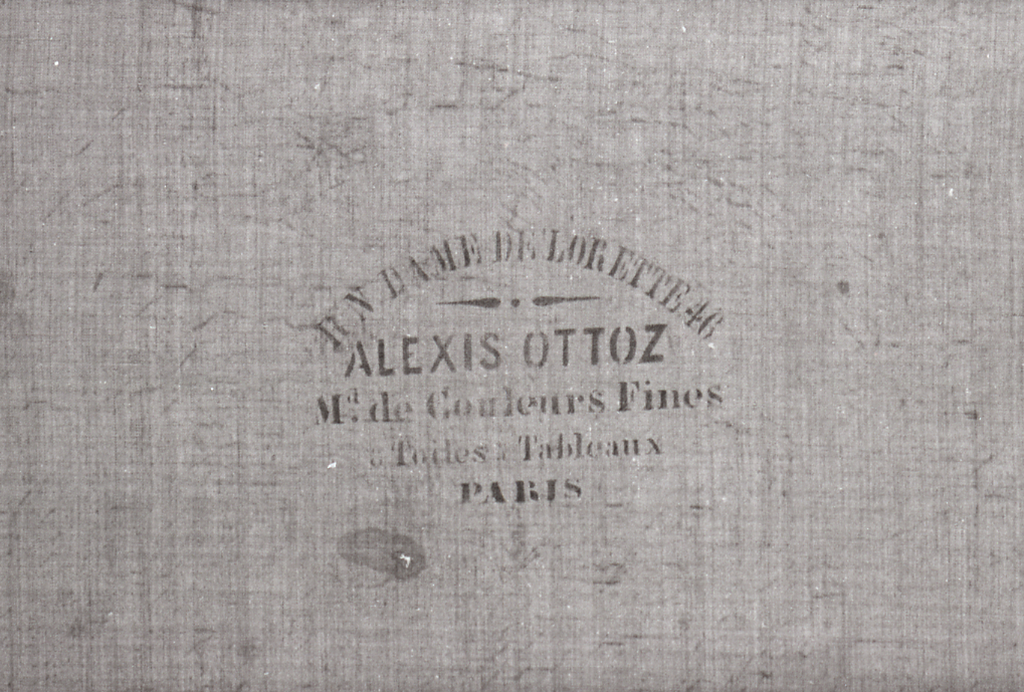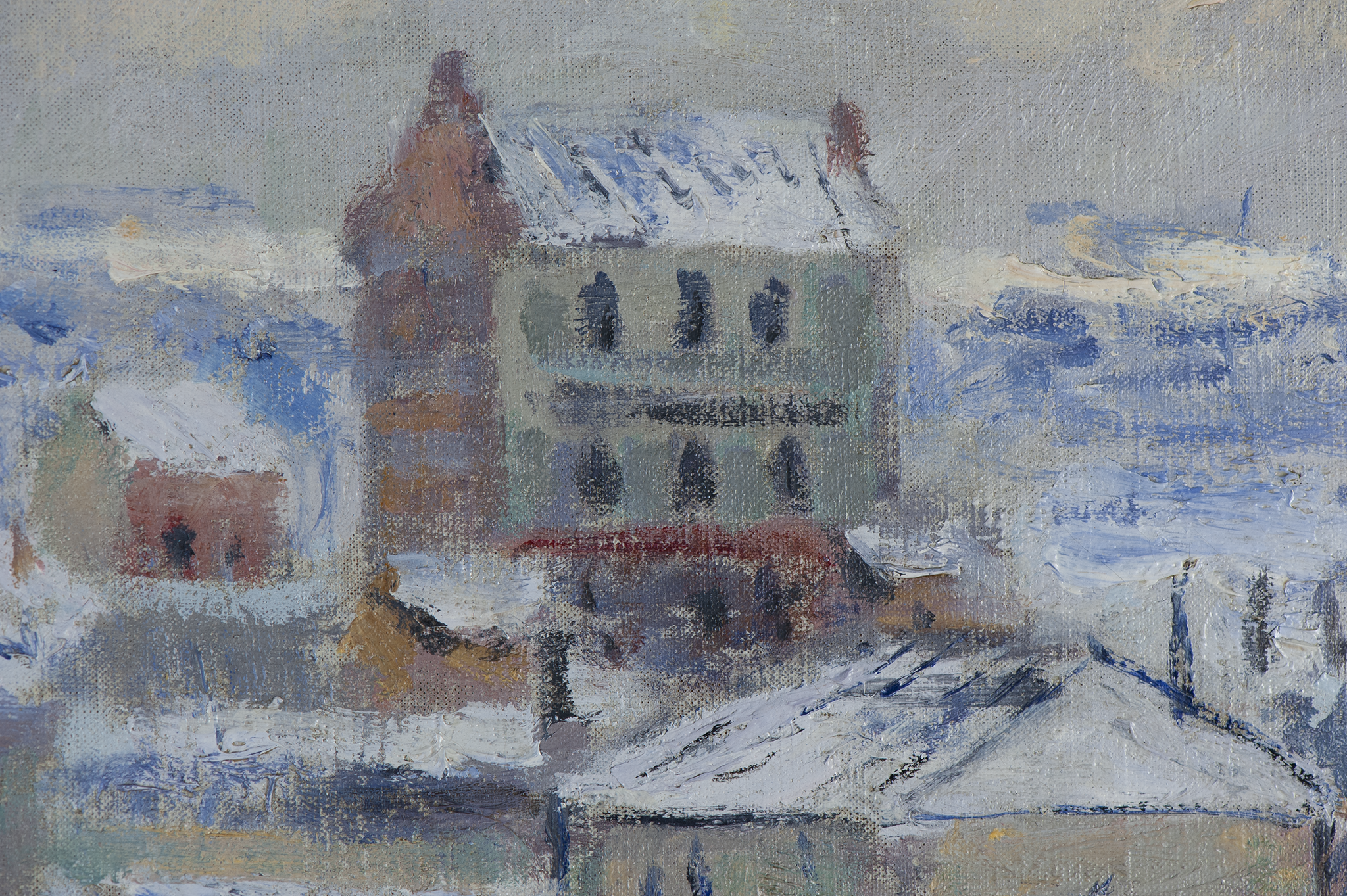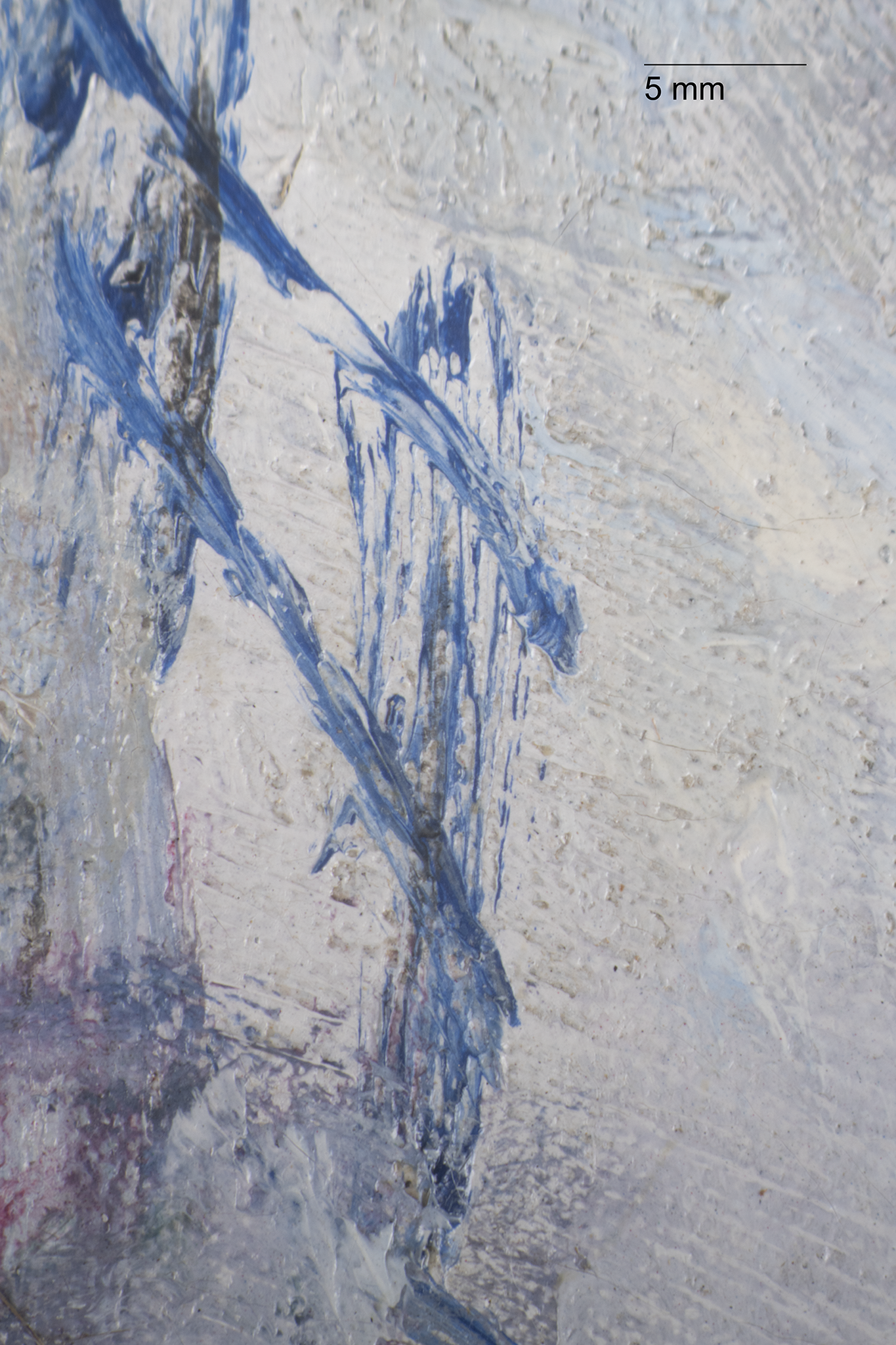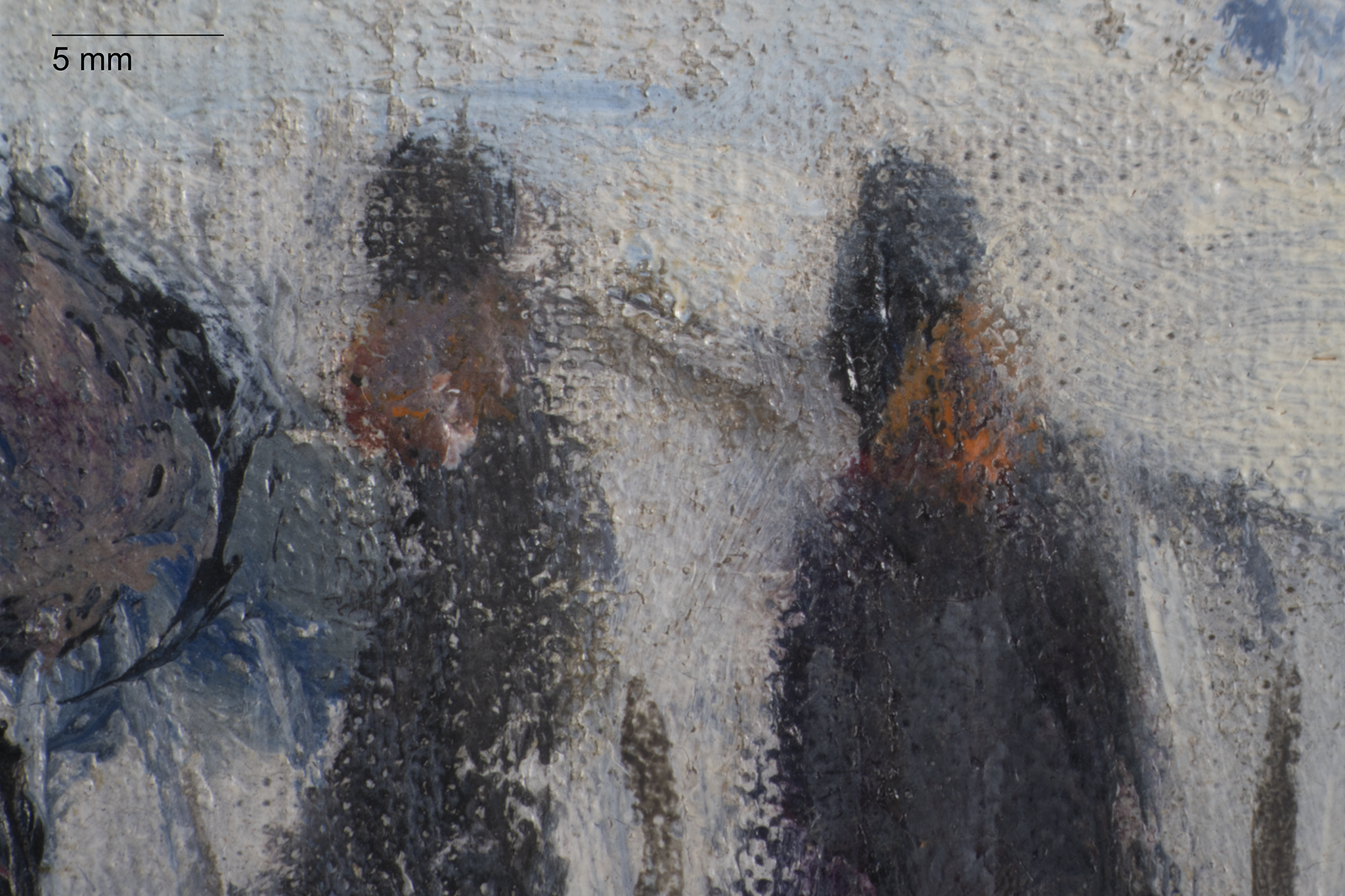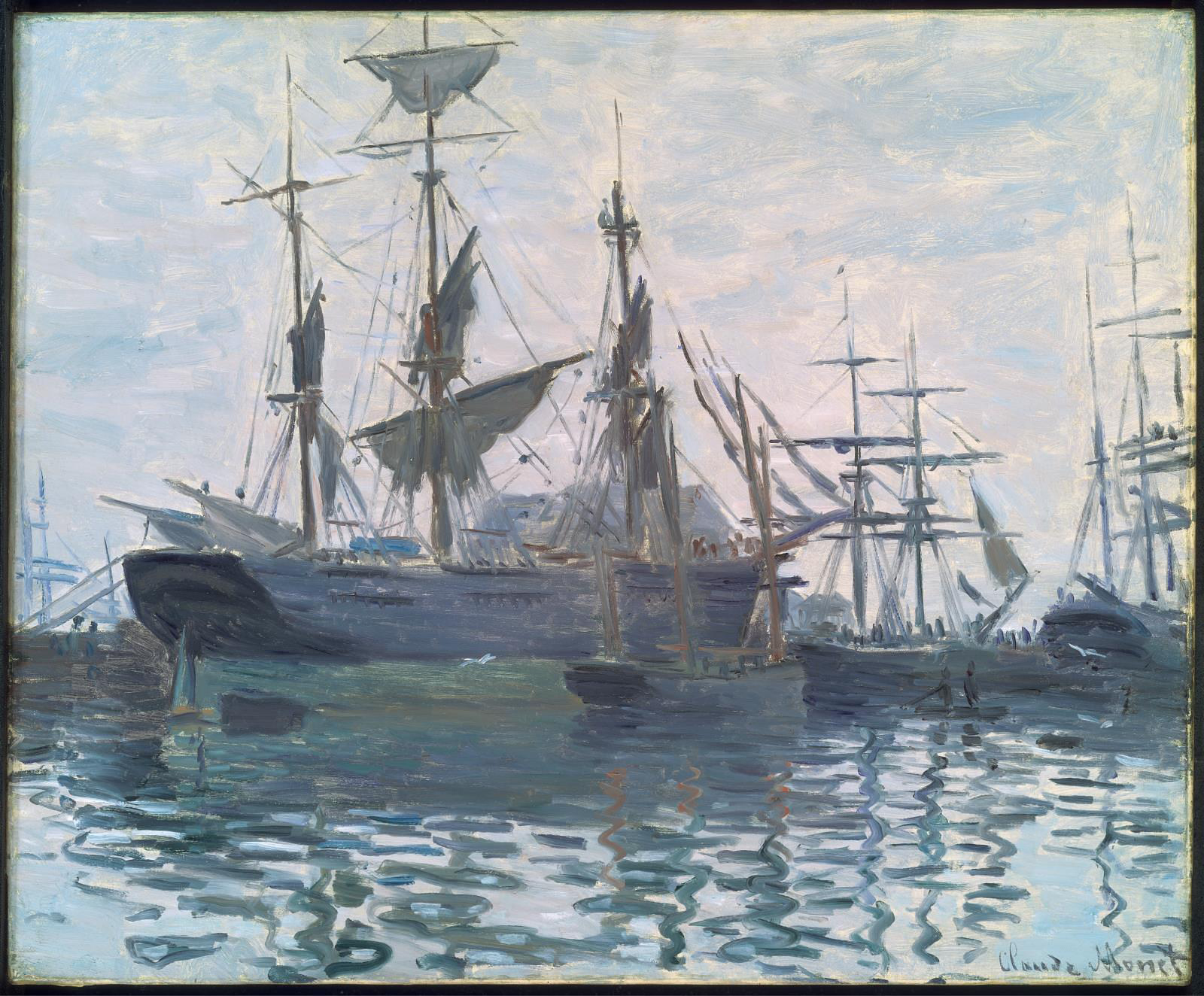Catalogue Entry
Citation
Chicago:
Glynnis Napier Stevenson, “Claude Monet, Snow Effect at Argenteuil, 1875, and Snow Effect at Argenteuil, 1875,” catalogue entry in ed. Aimee Marcereau DeGalan French Paintings and Pastels, 1600–1945: The Collections of the Nelson-Atkins Museum of Art (Kansas City: The Nelson-Atkins Museum of Art, 2021), https://doi.org/10.37764/78973.5.628.5407.
MLA:
Stevenson, Glynnis Napier. “Claude Monet, Snow Effect at Argenteuil, 1875, and Snow Effect at Argenteuil, 1875,” catalogue entry. French Paintings and Pastels, 1600–1945: The Collections of the Nelson-Atkins Museum of Art, edited by Aimee Marcereau DeGalan, The Nelson-Atkins Museum of Art, 2021. doi: 10.37764/78973.5.628.5407.
Claude Monet’s experiments in rendering effetseffets: French for “effects.” An artist’s emphasis on the atmospheric effects of time and weather on the subject matter. did not find broad appeal until the 1890s, which was consequently when Monet was finally free from the financial burdens that plagued him during the first half of his professional life. This change in circumstances is linked directly to the rise of the American nouveau riche at the end of the nineteenth century. Although wealthy Americans preferred landscapes by the Barbizon school of painters, they considered Monet a “safe” investment among the Impressionists, and he was the most widely collected member of the group in the United States.1Frances Weitzenhoffer, The Havemeyers: Impressionism Comes to America (New York: Harry N. Abrams, 1986), 92. Collectors in New York, Boston, and Chicago eagerly sought out his works after seeing them on display at the American Art Association exhibition of 1886, at the St. Botolph Club in Boston in 1890, and at the World’s Columbian Exposition in Chicago in 1893.2One Boston critic even referred to the St. Botolph Club as “the home of Impressionism” in the Boston Advertiser in 1890. Doris A. Birmingham, “Boston’s St. Botolph Club: Home of the Impressionists,” Archives of American Art Journal 31, no. 3 (1991): 26. Even Monet’s dealer Paul Durand-Ruel (1831–1922) said, “Without America, I would have been lost, ruined, after having bought so many Monets and Renoirs. The two exhibitions there in 1886 saved me. The American public bought moderately . . . but thanks to that public, Monet and Renoir were enabled to live, and after that the French public followed suit.”3For the month of April, Durand-Ruel’s exhibition was on display at the American Art Association, and then it moved to New York’s National Academy of Design in May, with additional artwork lent by American collectors. Sylvie Patry, ed., Inventing Impressionism: Paul Durand-Ruel and The Modern Art Market, exh. cat. (London: National Gallery, 2015), 136. Monet, however, was not as keen on Americans buying his paintings. He complained to Durand-Ruel in a letter dated July 28, 1885: “I have two canvases which I have been working on for a month, but I confess that certain of these pictures I would regret to see sent to the land of the Yankees. I would prefer to reserve a choice for Paris, because it is above all and only there that a little taste still exists.”4Weitzenhoffer, The Havemeyers, 40. Despite Monet’s misgivings, necessity drew him and Durand-Ruel to Gilded-Age America and its new class of collectors.
Throughout the 1870s, Monet was an itinerant and impoverished painter. While Paris was the center of the art world at the time, the great expense of living in the city forced him and his family to live in the suburb of Argenteuil. He; his wife, Camille; and their son, Jean, would stay there until the end of 1878, when their second son, Michel, was born and Camille’s health began to fail. During the course of their stay, Argenteuil was both a new industrial center and a popular weekend destination for Parisians, who liked to spend their leisure time boating on the Seine. Since it was only a fifteen-minute trip from Paris’s Gare de l’Ouest train station, Argenteuil earned the nickname “la colonnie parisienne” (the Parisian colony).5T. J. Clark, The Painting of Modern Life (Princeton, NJ: Princeton University Press, 1984), 173–74. Clark’s study of the Impressionists and the urbanism that shaped their art goes into depth about Argenteuil’s industrialism and Monet’s depiction of the town.
From 1871 to 1878, Monet painted approximately 150 canvases featuring Argenteuil, of which about eighteen depict the snowfall of 1874–1875, including these two snowy landscapes, both titled Snow Effect at Argenteuil. These pictures were part of Monet’s lifelong obsession with capturing effets. We can see this in the interchangeable titles he gave his works within his various series; he titled many of his snow scenes simply Effet de neige (Snow Effect). Forms and subject matter play a secondary role to the ambience of weather and time, a feature of Monet’s work that is evident from his early landscapes in Argenteuil to his late paintings of the water lily pond at Giverny.6Of Monet’s primary artistic concerns, the French art historian Louis Gillet wrote, “This study of l’enveloppe, this analysis of the proper role of light, what it adds or takes away from the colors of the real world. . . . Light becomes the main character of the painting. Everything else is of secondary importance: (Cette étude de l’enveloppe, cette analyse du rôle propre de la lumière, de ce qu’elle ajoute ou qu’elle ôte aux couleurs du monde reel. . . . La lumière deviant le personnage principal du tableau. Tout le reste n’a plus qu’une importance secondaire). Louis Gillet, Trois variations sur Claude Monet (Paris: Plon, 1927), 52–53. Translation is my own.
In the winter of 1874–1875, large snowstorms blanketed Argenteuil, and Monet worked quickly to capture the various effets created by the snow. In Snow Effect at Argenteuil (44-41/3), Monet used an icy white-and-blue palette to depict a blisteringly cold wind assailing pedestrians as they trudge up the curving path of the Boulevard Saint-Denis. Our vantage point in this picture is the second story of Monet’s home on that street.7Monet signed a letter to his friend and patron Victor Chocquet, dated February 4, 1876: “Yours most sincerely, Claude Monet, 2 Boulevard St. Denis, opposite the train station, pink house with green shutters.” Richard Kendall, ed., Monet by Himself: Paintings, Drawings, Pastels, Letters, trans. Bridget Strevens Romer (Edison, NJ: Chartwell Books, 1996), 29. From his window, he could see the townscape of Argenteuil,8Argenteuil was home to twenty factories, which Monet blends into the fabric of his scenes without letting them dominate. His urban landscapes are rarely subsumed by industrialization, a fact that Clark bemoans. He compares this elision of labor to Monet’s later works done at Giverny, which were never marred by the train tracks that cut through his garden. Clark, The Painting of Modern Life, 174, 188. with its scattered rooftops and chimneystacks, and the Argenteuil train platform. (This easy access to trains to Paris was a necessity for Monet’s regular visits to Durand-Ruel.) When the flurries subsided, Monet ventured out of his home to seek new sites for what would become Snow Effect at Argenteuil (2015.13.14). In that work, he used earthy browns and greens to render the melting snow. It has a much warmer palette overall and appears to have been painted in early spring. As T. J. Clark has shown, Monet only painted the environs of Argenteuil, and not the town itself, until early 1875.9Clark, The Painting of Modern Life, 193; see also Clark’s essay, “The Environs of Paris,” in Mary Tompkins Lewis, ed., Critical Readings in Impressionism and Post-Impressionism: An Anthology (Berkeley: University of California Press, 2007), 133. Thus, when Monet first sought a buyer for these Argenteuil snow paintings, they were less than two months old, which speaks to his need to turn a profit.
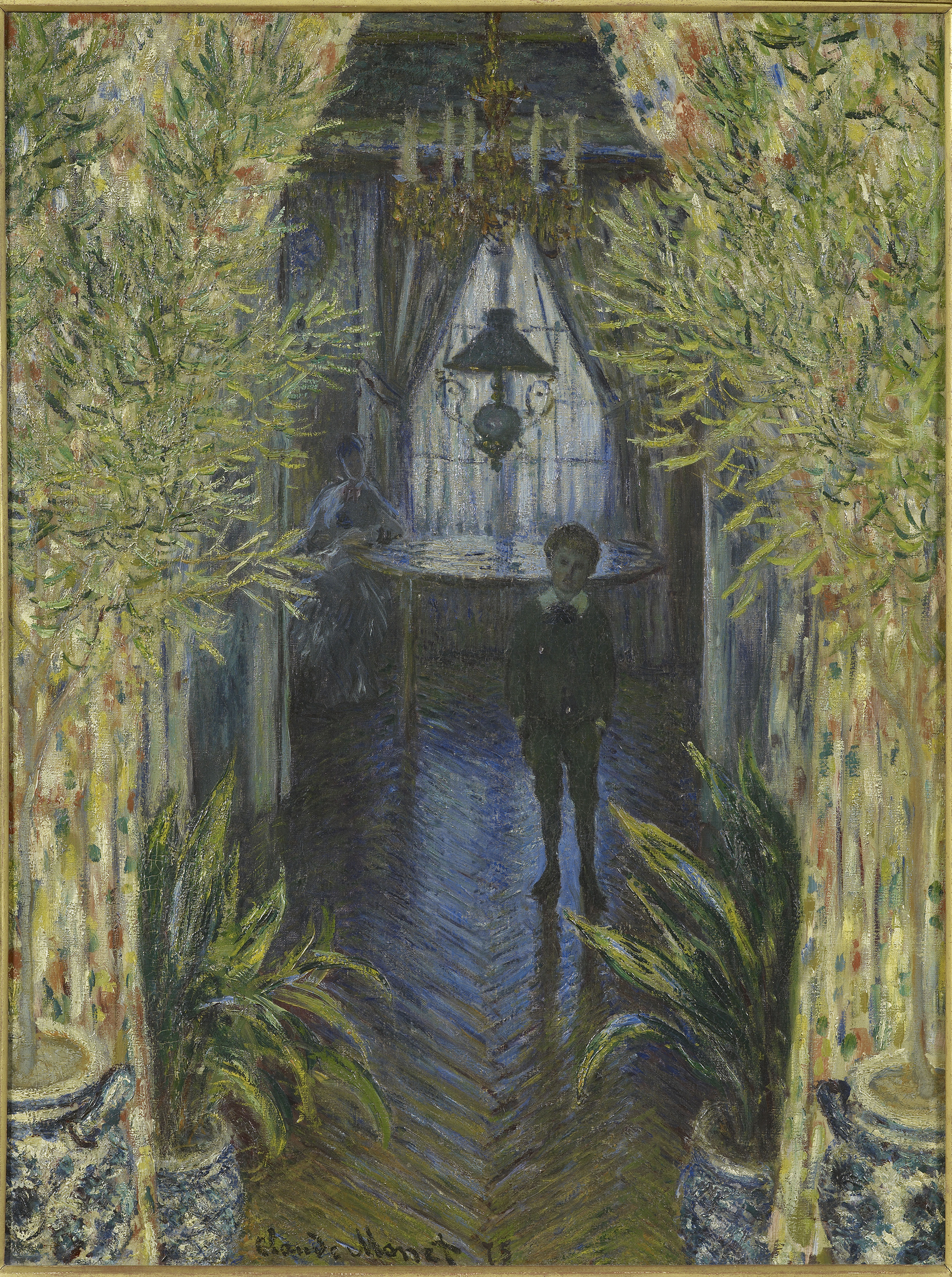
 Fig. 2. Claude Monet, La Mare, effet de neige (The Pond, Snow Effect), 1875, oil on canvas, 23 3/5 x 31 9/10 in. (60 x 81 cm), private collection
Fig. 2. Claude Monet, La Mare, effet de neige (The Pond, Snow Effect), 1875, oil on canvas, 23 3/5 x 31 9/10 in. (60 x 81 cm), private collection
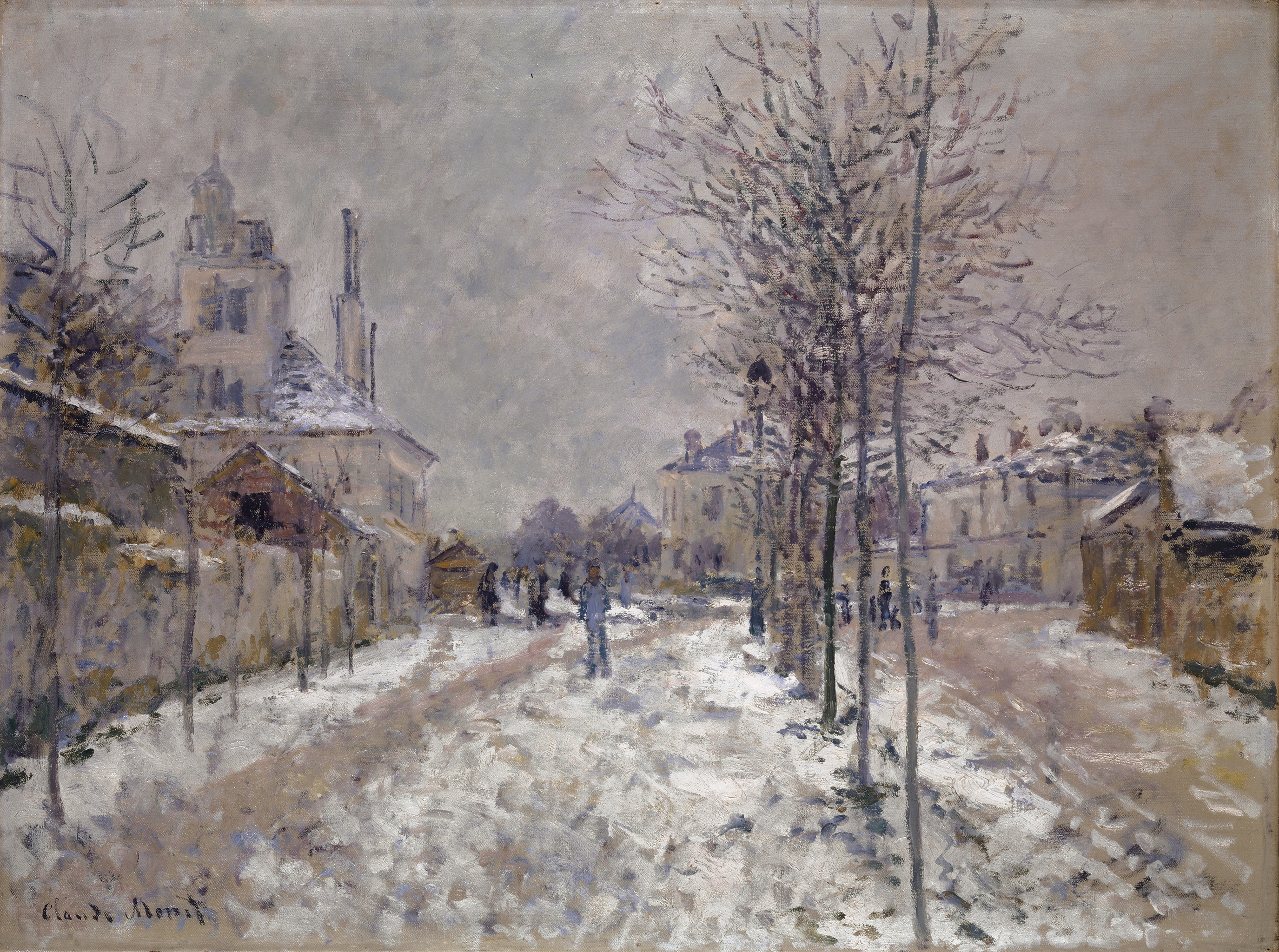 Fig. 3. Claude Monet, Pontoise Boulevard in Argenteuil, Snow, 1875, oil on canvas, 23 4/5 x 32 in. (60.5 x 81.5 cm), Kunstmuseum Basel, Switzerland, inv. 2320
Fig. 3. Claude Monet, Pontoise Boulevard in Argenteuil, Snow, 1875, oil on canvas, 23 4/5 x 32 in. (60.5 x 81.5 cm), Kunstmuseum Basel, Switzerland, inv. 2320
Unlike in Paris, the American reaction to Impressionism was not overtly hostile, and several notable collectors, such as Alexander Cassatt (1839–1906), older brother of the artist Mary Cassatt (1844–1926), and Henry O. Havemeyer (1847–1907), the “Sugar King,” lent paintings to Durand-Ruel’s American Art Association exhibition in 1886.15Havemeyer had joined his family’s sugar refining business at age fifteen and turned it into one of America’s largest trusts, the Sugar Refineries Company (known as the Sugar Trust), in 1887. The fortune he accrued enabled him and his wife, Louisine, to amass one of the country’s most significant art collections. For more on the Havemeyers, see Weitzenhoffer, The Havemeyers. This exhibition of Impressionist and Barbizon pictures opened on April 10, 1886, inspiring many American artists to travel to Impressionist haunts in Europe, such as Monet’s garden in Giverny. Motivated both by this success and by new tariffs on paintings purchased abroad, Durand-Ruel opened a New York branch at 297 Fifth Avenue in 1888 and turned over its management to his sons, Joseph, Charles, and George.16Weitzenhoffer, The Havemeyers, 43. The exhibition was subsequently moved to the National Academy of Design following a campaign by American dealers to impose a 30% tax on foreign paintings intended to be sold. The National Academy of Design was a purely noncommercial space and thus posed less of a threat to for-profit American galleries. In 1883, the United States Congress passed a law imposing a 30% tariff on artwork produced abroad, although they often gave exemptions to works created by American expatriate artists. Robert E. May, “Culture Wars: The U.S. Art Lobby and Congressional Tariff Legislation during the Gilded Age and Progressive Era,” Journal of the Gilded Age and Progressive Era 9, no. 1 (January 2010): 1. One of Durand-Ruel’s French rivals, the firm of Boussod, Valadon, et Cie, swiftly followed suit, opening its own Fifth Avenue venue just one block away in the fall of 1888.17Weitzenhoffer, The Havemeyers, 84.
The increasing appetite for Impressionist pictures, and the number of dealers jockeying to sell them in America and France, compromised the exclusivity of representation that Durand-Ruel had once enjoyed. By the late 1880s, he struggled to maintain his proprietary relationships with the artists he supported through their early years. Monet was especially anxious not to limit himself to one dealer, and, to Durand-Ruel’s dismay, Monet co-organized a large exhibition of his paintings at Galerie Georges Petit in Paris, which opened June 21, 1889. It was common practice for dealers of Impressionist art to feature their avant-garde painters alongside more established Barbizon landscape art in an effort to equate the two in viewers’ minds.18Gilded-Age Americans were passionate collectors of Salon-approved French Barbizon artists such as Constant Troyon (1810–1865) and Charles Daubigny (1817–1878). By exhibiting Impressionist art alongside Barbizon landscapes, dealers drew connections between these two modes of painting. For more on Gilded-Age collecting, see Gabriel P. Weisberg, DeCourcy E. McIntosh, and Alison McQueen, Collecting in the Gilded Age: Art Patronage in Pittsburgh, 1890–1910, exh. cat. (Pittsburgh: Frick Art and Historical Center, 1997). However, in the case of the Galerie Georges Petit exhibition, Monet exhibited alongside Auguste Rodin (1840–1917), who defied categorization within any artistic movement and was considered the preeminent sculptor of his time.19In his glowing review of the 1889 exhibition, the critic Theodore Child wrote of Rodin, “He is the great sculptor of our day and his name will figure in the annals of this century after those of Rude, Barye and Carpeaux.” Although his comments on Monet are less adulatory, they are still very positive. Theodore Child, “Two Notable French Artists,” Art Amateur 21, no. 4 (September 1889): 67. Among the works Monet selected for this special exhibition was the Nelson-Atkins Snow Effect at Argenteuil (2015.13.14), which appeared in the catalogue without a lender.20Claude Monet; A. Rodin, exh. cat. (Paris: Galerie Georges Petit, 1889), no. 18, p. 29, as Effet de neige; Argenteuil. Several other paintings in the exhibition were in Monet’s private collection at this time, and it is possible that the Nelson-Atkins picture came from him directly. Durand-Ruel had often lent Monet’s work from his private collection to aid in sales; however, hurt by Monet’s perceived betrayal at mounting his own exhibition, he refused to lend the artist anything for this show.
Durand-Ruel retained Snow Effect at Argenteuil (44-41/3) in his private collection until 1891, when the value of Impressionist painting was newly recognized. In August 1891, he sold Snow Effect at Argenteuil to the Paris branch of his gallery, Durand-Ruel et Cie. They ultimately sold it five years later, on May 21, 1896, to a Kansas City publisher, William Rockhill Nelson (1841–1915), cofounder of The Kansas City Star and one of the two namesakes of the Nelson-Atkins Museum of Art.21Durand-Ruel et Cie to Myers, January 11, 2016. Nelson had embarked on a six-month trip to Europe in 1896, when he purchased many works of art, ranging from painting to photography, and it is likely that he stopped in at the Paris branch of Durand-Ruel that May to purchase Snow Effect of Argenteuil.22Michael Churchman and Scott Erbes discuss Nelson’s 1896 trip to Europe but do not make it clear what works were purchased at that time. They note that at the time of Nelson’s death, his “Western Gallery of Art” contained sixty copies of paintings, thirty casts of sculpture, and 450 photographic reproductions. See Michael Churchman and Scott Erbes, High Ideals and Aspirations: The Nelson-Atkins Museum of Art, 1933–1993 (Kansas City, MO: Nelson-Atkins Museum of Art, 1993), 9–10. Nelson also purchased Edgar Degas’s After the Bath: Seated Woman Drying Herself and Camille Pissarro’s Poplars, Sunset at Eragny from Durand-Ruel. As he did not consider himself a connoisseur of modern art, Nelson trusted this dealer who was most responsible for enhancing the Impressionists’ reputation internationally.
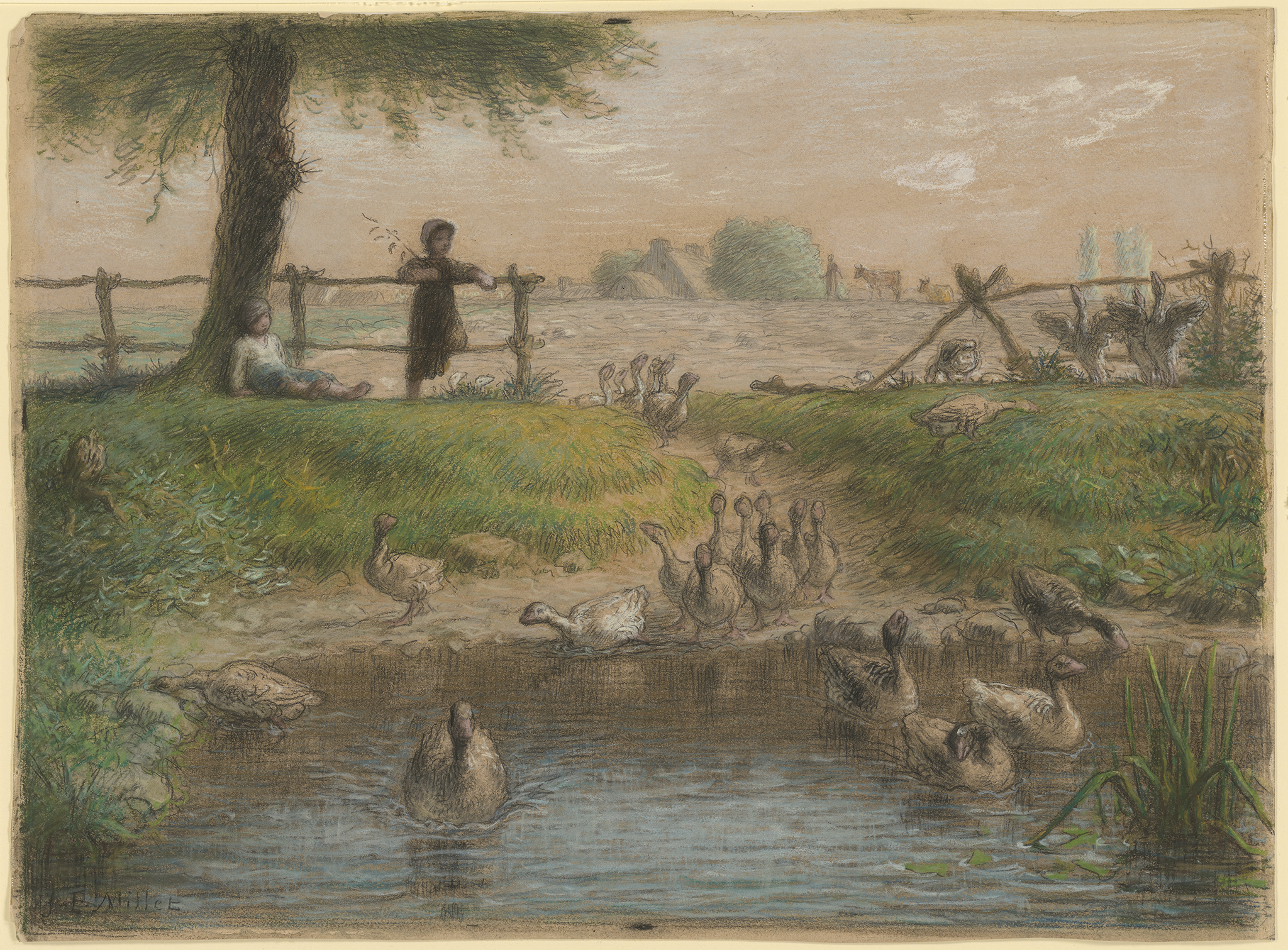
Notes
-
Frances Weitzenhoffer, The Havemeyers: Impressionism Comes to America (New York: Harry N. Abrams, 1986), 92.
-
One Boston critic even referred to the St. Botolph Club as “the home of Impressionism” in the Boston Advertiser in 1890. Doris A. Birmingham, “Boston’s St. Botolph Club: Home of the Impressionists,” Archives of American Art Journal 31, no. 3 (1991): 26.
-
For the month of April, Durand-Ruel’s exhibition was on display at the American Art Association, and then it moved to New York’s National Academy of Design in May, with additional artwork lent by American collectors. Sylvie Patry, ed., Inventing Impressionism: Paul Durand-Ruel and The Modern Art Market, exh. cat. (London: National Gallery, 2015), 136.
-
Weitzenhoffer, The Havemeyers, 40.
-
T. J. Clark, The Painting of Modern Life (Princeton, NJ: Princeton University Press, 1984), 173–74. Clark’s study of the Impressionists and the urbanism that shaped their art goes into depth about Argenteuil’s industrialism and Monet’s depiction of the town.
-
Of Monet’s primary artistic concerns, the French art historian Louis Gillet wrote, “This study of l’enveloppe, this analysis of the proper role of light, what it adds or takes away from the colors of the real world. . . . Light becomes the main character of the painting. Everything else is of secondary importance” (Cette étude de l’enveloppe, cette analyse du rôle propre de la lumière, de ce qu’elle ajoute ou qu’elle ôte aux couleurs du monde reel. . . . La lumière deviant le personnage principal du tableau. Tout le reste n’a plus qu’une importance secondaire). Louis Gillet, Trois variations sur Claude Monet (Paris: Plon, 1927), 52–53. Translation is my own.
-
Monet signed a letter to his friend and patron Victor Chocquet, dated February 4, 1876: “Yours most sincerely, Claude Monet, 2 Boulevard St. Denis, opposite the train station, pink house with green shutters.” Richard Kendall, ed., Monet by Himself: Paintings, Drawings, Pastels, Letters, trans. Bridget Strevens Romer (Edison, NJ: Chartwell Books, 1996), 29.
-
Argenteuil was home to twenty factories, which Monet blends into the fabric of his scenes without letting them dominate. His urban landscapes are rarely subsumed by industrialization, a fact that Clark bemoans. He compares this elision of labor to Monet’s later works done at Giverny, which were never marred by the train tracks that cut through his garden. Clark, The Painting of Modern Life, 174, 188.
-
Clark, The Painting of Modern Life, 193; see also Clark’s essay, “The Environs of Paris,” in Mary Tompkins Lewis, ed., Critical Readings in Impressionism and Post-Impressionism: An Anthology (Berkeley: University of California Press, 2007), 133.
-
Tableaux et Aquarelles par Claude Monet, Berthe Morisot, A. Renoir, A. Sisley, exh. cat. (Paris: Hôtel Drouot, March 24, 1875).
-
There is some debate about the exact amount earned by the combined efforts of Monet, Renoir, Sisley, and Morisot, but in every case, the amount was a fraction of what they had hoped for. Merete Bodelsen, “Early Impressionist Sales 1874–94 in the Light of Some Unpublished ‘Procès-Verbaux,’” Burlington Magazine 110, no. 783 (June 1968): 331.
-
Bodelsen, “Early Impressionist Sales,” 333.
-
Furthermore, Daniel Wildenstein’s catalogue raisonné lists the Nelson-Atkins work as tentatively in Durand-Ruel’s collection by 1876. Daniel Wildenstein, Monet, vol. 2, Catalogue Raisonné-Werkverzeichnis: Nos. 1–968 (Cologne: Benedikt Taschen Verlag GmbH, 1996), no. 358, p. 148. Durand-Ruel definitely had the painting by 1879, when he lent it to the Fourth Impressionist Exhibition.
-
Catalogue de la 4me Exposition de peinture par M. Bracquemond—Mme Bracquemond—M. Caillebotte—M. Cals—Mlle Cassatt—MM. Degas—Forain—Lebourg—Monet—Pissarro—Feu Piette—Rouart—H. Somm—Tillot et Zandomenighi, Du 10 Avril au 11 Mai 1879, exh. cat. (Paris: Morris, père et fils 1879), 12, no. 159, as Effet de neige (1875) à Argenteuil, listed as “belonging to M. Durand Ruel.” The catalogue is reprinted in Theodore Reff, ed., Modern Art in Paris: Two-Hundred Catalogues of the Major Exhibitions Reproduced in Facsimile in Forty-Seven Volumes, vol. 23, Impressionist Group Exhibitions (New York: Garland, 1981), unpaginated.
-
Havemeyer had joined his family’s sugar refining business at age fifteen and turned it into one of America’s largest trusts, the Sugar Refineries Company (known as the Sugar Trust), in 1887. The fortune he accrued enabled him and his wife, Louisine, to amass one of the country’s most significant art collections. For more on the Havemeyers, see Weitzenhoffer, The Havemeyers.
-
Weitzenhoffer, The Havemeyers, 43. The exhibition was subsequently moved to the National Academy of Design following a campaign by American dealers to impose a 30% tax on foreign paintings intended to be sold. The National Academy of Design was a purely noncommercial space and thus posed less of a threat to for-profit American galleries. In 1883, the United States Congress passed a law imposing a 30% tariff on artwork produced abroad, although they often gave exemptions to works created by American expatriate artists. Robert E. May, “Culture Wars: The U.S. Art Lobby and Congressional Tariff Legislation during the Gilded Age and Progressive Era,” Journal of the Gilded Age and Progressive Era 9, no. 1 (January 2010): 1.
-
Weitzenhoffer, The Havemeyers, 84.
-
Gilded-Age Americans were passionate collectors of Salon-approved French Barbizon artists such as Constant Troyon (1810–1865) and Charles Daubigny (1817–1878). By exhibiting Impressionist art alongside Barbizon landscapes, dealers drew connections between these two modes of painting. For more on Gilded-Age collecting, see Gabriel P. Weisberg, DeCourcy E. McIntosh, and Alison McQueen, Collecting in the Gilded Age: Art Patronage in Pittsburgh, 1890–1910, exh. cat. (Pittsburgh: Frick Art and Historical Center, 1997).
-
In his glowing review of the 1889 exhibition, the critic Theodore Child wrote of Rodin, “He is the great sculptor of our day and his name will figure in the annals of this century after those of Rude, Barye and Carpeaux.” Although his comments on Monet are less adulatory, they are still very positive. Theodore Child, “Two Notable French Artists,” Art Amateur 21, no. 4 (September 1889): 67.
-
Claude Monet; A. Rodin, exh. cat. (Paris: Galerie Georges Petit, 1889), no. 18, p. 29, as Effet de neige; Argenteuil.
-
Durand-Ruel et Cie to Myers, January 11, 2016.
-
Michael Churchman and Scott Erbes discuss Nelson’s 1896 trip to Europe but do not make it clear what works were purchased at that time. They note that at the time of Nelson’s death, his “Western Gallery of Art” contained sixty copies of paintings, thirty casts of sculpture, and 450 photographic reproductions. See Michael Churchman and Scott Erbes, High Ideals and Aspirations: The Nelson-Atkins Museum of Art, 1933–1993 (Kansas City, MO: Nelson-Atkins Museum of Art, 1993), 9–10.
-
Weitzenhoffer, The Havemeyers, 91.
Claude Monet, Snow Effect at Argenteuil, 44-41/3
Technical Entry
Citation
Chicago:
Diana M. Jaskierny, “Claude Monet, Snow Effect at Argenteuil, 1875 (44-41/3)” technical entry in ed. Aimee Marcereau DeGalan French Paintings and Pastels, 1600–1945: The Collections of the Nelson-Atkins Museum of Art (Kansas City: The Nelson-Atkins Museum of Art, 2021), https://doi.org/10.37764/78973.5.628.2088.
MLA:
Jaskierny, Diana M. “Claude Monet, Snow Effect at Argenteuil, 1875 (44-41/3)” technical entry. French Paintings and Pastels, 1600–1945: The Collections of the Nelson-Atkins Museum of Art, edited by Aimee Marcereau DeGalan, The Nelson-Atkins Museum of Art, 2021. doi: 10.37764/78973.5.628.2088.
While not used as a significant feature within the composition, the ground layer is visible with the naked eye around buildings and within the trees. Off-white in color, the ground layer may have originally been a brighter white that darkened slightly during the lining process.3While tinted grounds became common for Monet by the 1870s, white grounds were commonly used by the Impressionists to increase luminosity. Anthea Callen, The Art of Impressionism: Painting Technique and the Making of Modernity (New Haven: Yale University Press, 2000), 70. See also Anthea Callen, Techniques of the Impressionists (London: Tiger Books International, 1990), 55.,4Later in life Monet returned to using canvas with white ground layers. Bomford et al., Art in the Making: Impressionism, 89. No underdrawingunderdrawing: A drawn or painted sketch beneath the paint layer. The underdrawing can be made from dry materials, such as graphite or charcoal, or wet materials, such as ink or paint. was found when the piece was examined with infrared reflectography (IRR)infrared reflectography (IRR): A form of infrared imaging that exploits the behavior of painting materials at wavelengths beyond those accessible to infrared photography. These advantages sometimes include a continuing increase in the transparency of pigments beyond wavelengths accessible to infrared photography (i.e, beyond 1,000 nanometers), rendering underdrawing more clearly. The resulting image is called an infrared reflectogram. Devices that came into common use in the 1980s such as the infrared vidicon effectively revealed these features but suffered from lack of sharpness and uneven response. Vidicons continue to be used out to 2,200 nanometers but several newer pixelated detectors including indium gallium arsenide and indium antimonide array detectors offer improvements. All of these devices are optimally used with filters constraining their response to those parts of the infrared spectrum that reveal the most within the constraints of the palette used for a given painting. They can be used for transmitted light imaging as well as in reflection.. Additionally, no underpainting or sketching out of the composition was detected. Instead, it is believed Claude Monet worked directly onto the canvas while looking out his window.5See the accompanying catalogue entry by Glynnis Napier Stevenson.
Snow Effect at Argenteuil is made up of a wide variety of strokes, from thin dry passages, to dots and dabs, to flat blocks, to incised lines.6For an overview of Monet’s paint handling during this period, see John House, Monet: Nature into Art (New Haven: Yale University Press, 1986), 75–83. With both wet-over-wetwet-over-wet: An oil painting technique which involves drawing a stroke of one color across the wet paint of another color. and wet-over-drywet-over-dry: An oil painting technique that involves layering paint over an already dried layer, resulting in no intermixing of paint or disruption to the lower paint strokes. paint applications found throughout the composition, it is clear that Monet worked quickly at times, but also revisited the painting in numerous sessions, likely from the comfort of his home. Monet’s work is often described as alla prima (Italian for “at first attempt”) and école de plein-air (French for “open-air school”) because of his frequent work outdoors, completing paintings in a single sitting. However, his contemporaries described his multiple painting sessions per canvas, returning to make changes until he was satisfied. During his various outdoor “Effet” series, such as this painting, there would be only a small window of time to capture the scene with the desired lighting, preventing long painting periods, and encouraging multiple sessions.7Bomford et al., Art in the Making: Impressionism, 27, 91. See also Andrea Kirsh and Rustin S. Levenson, Seeing Through Paintings: Physical Examination in Art Historical Studies (New Haven: Yale University Press, 2000), 123. Here, as in Boulevard des Capucines (1871), the wet-over-dry applications clearly indicate time passing between painting sessions. It is possible that this was more manageable with these two paintings, as they were both painted looking out from artists’ studios,8Boulevard des Capucines (1873–1874; The Nelson-Atkins Museum of Art) was painted looking out from Nadar’s studio. Ian Kennedy, “Monet’s Boulevard des Capucines: Kansas City or Moscow?,” Apollo: The International Magazine of Art and Antiques 165, no. 541 (2007): 69. For more information on the relationship between Monet and Nadar, see Aimee Marcereau DeGalan, “Claude Monet, Boulevard des Capucines, 1873—1874,” catalogue entry in ed. Aimee Marcereau DeGalan French Paintings, 1600–1945: The Collections of the Nelson-Atkins Museum of Art (Kansas City: The Nelson-Atkins Museum of Art, 2021), https://doi.org/10.37764/78973.5.626.5407. and therefore could be revisited easily from their respective vantage points.9This is in comparison to Snow Effect at Argenteuil (1875; The Nelson-Atkins Museum of Art, 2015.13.14) which was painted en plein air and has predominantly wet-over-wet paint application.
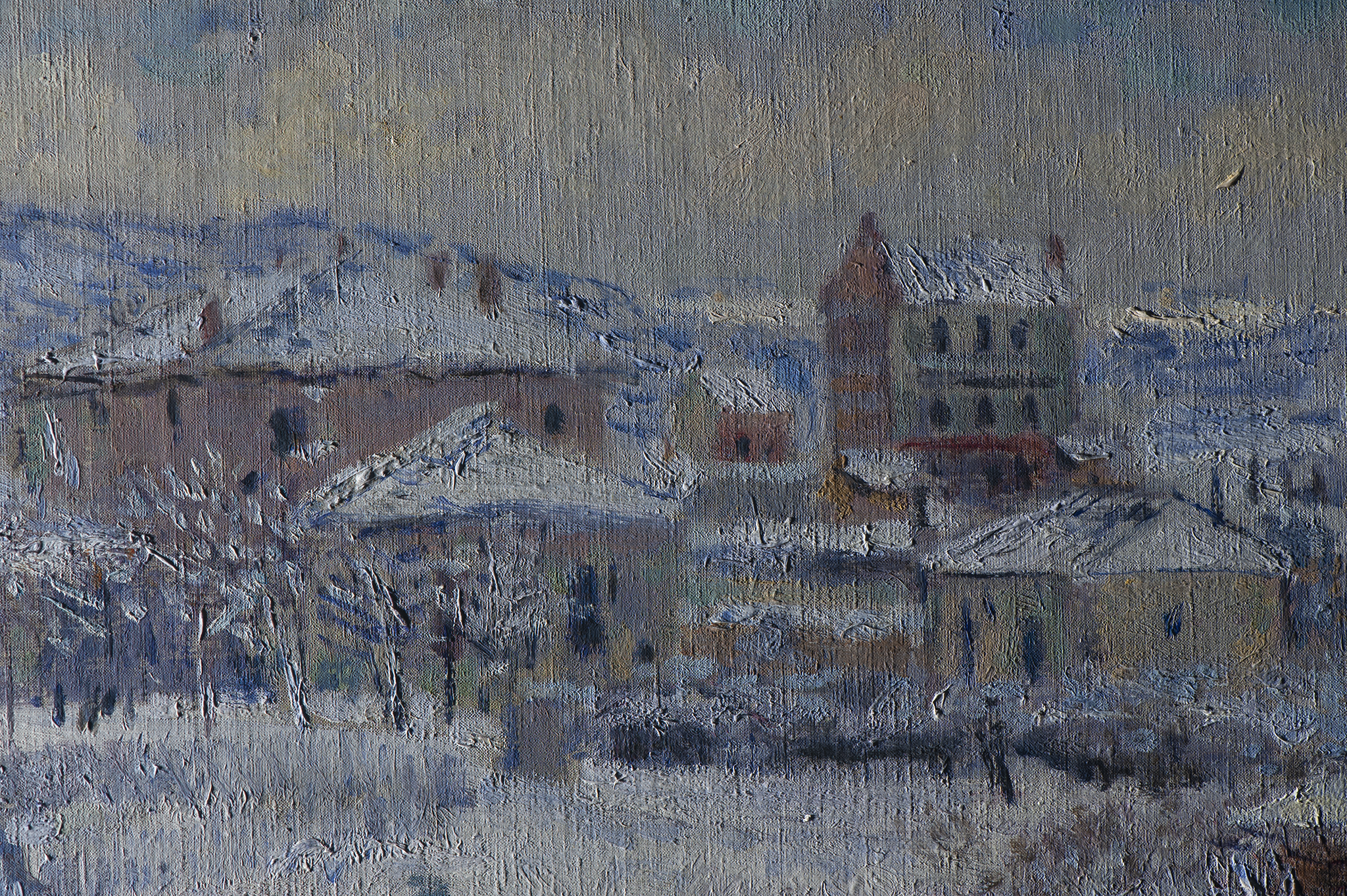 Fig. 6. Raking light detail illustrating the impasto of the background buildings’ rooftops and trees, Snow Effect at Argenteuil (1875; 44-41/3)
Fig. 6. Raking light detail illustrating the impasto of the background buildings’ rooftops and trees, Snow Effect at Argenteuil (1875; 44-41/3)
 Fig. 7. Detail of background trees in which the white paint of the snow creates the illusion of tree branches (left), and photomicrograph in raking light of foreground tree incised lines and brown branches (right), Snow Effect at Argenteuil (1875; 44-41/3)
Fig. 7. Detail of background trees in which the white paint of the snow creates the illusion of tree branches (left), and photomicrograph in raking light of foreground tree incised lines and brown branches (right), Snow Effect at Argenteuil (1875; 44-41/3)
There is some slight impastoimpasto: A thick application of paint, often creating texture such as peaks and ridges., mostly found in the white regions of piled snow, that contrasts with thinly painted elements. For example, the buildings at center right are painted with broad, flat blocks of color, while the impasto of the snow-covered rooftop creates the illusion of snow resting atop the architecture (Fig. 6). The same is true with the nearby trees, where there are often few or no indications of the branches, but the impastoed dabs of white paint imply the tree’s structure. Conversely, in the lower center tree, both thin, translucent brown paint and incised lines in the still-wet snowy foreground form the branches (Fig. 7). A similar divergence in how Monet painted compositional elements is evident among the various structures. While the buildings’ sides were painted with broad, flat strokes and few details, the center right building that eclipses the horizon has a single dark mark in the center of each window, a detail unique to this structure (Fig. 8).
The large tree on the left side of the foreground was added while the underlying snowy paint was still quite wet, forming marbleized swirls, loosely painted in blues and violets (Fig. 10). Although the central foreground tree was painted into the still-wet snowy backdrop, Monet added the light blue brushstrokes as a final detail after the underlying paint had dried (Fig. 11).
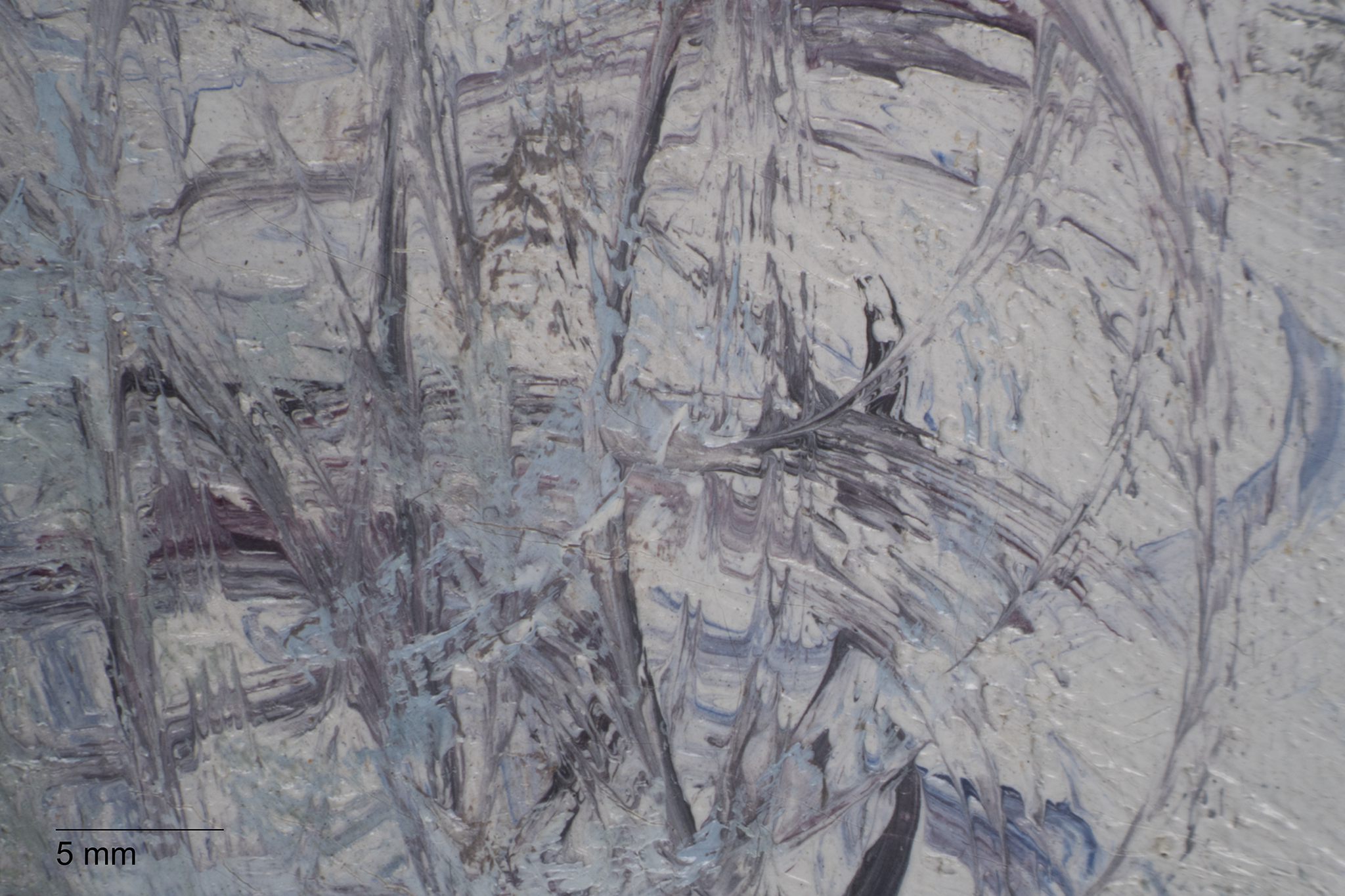
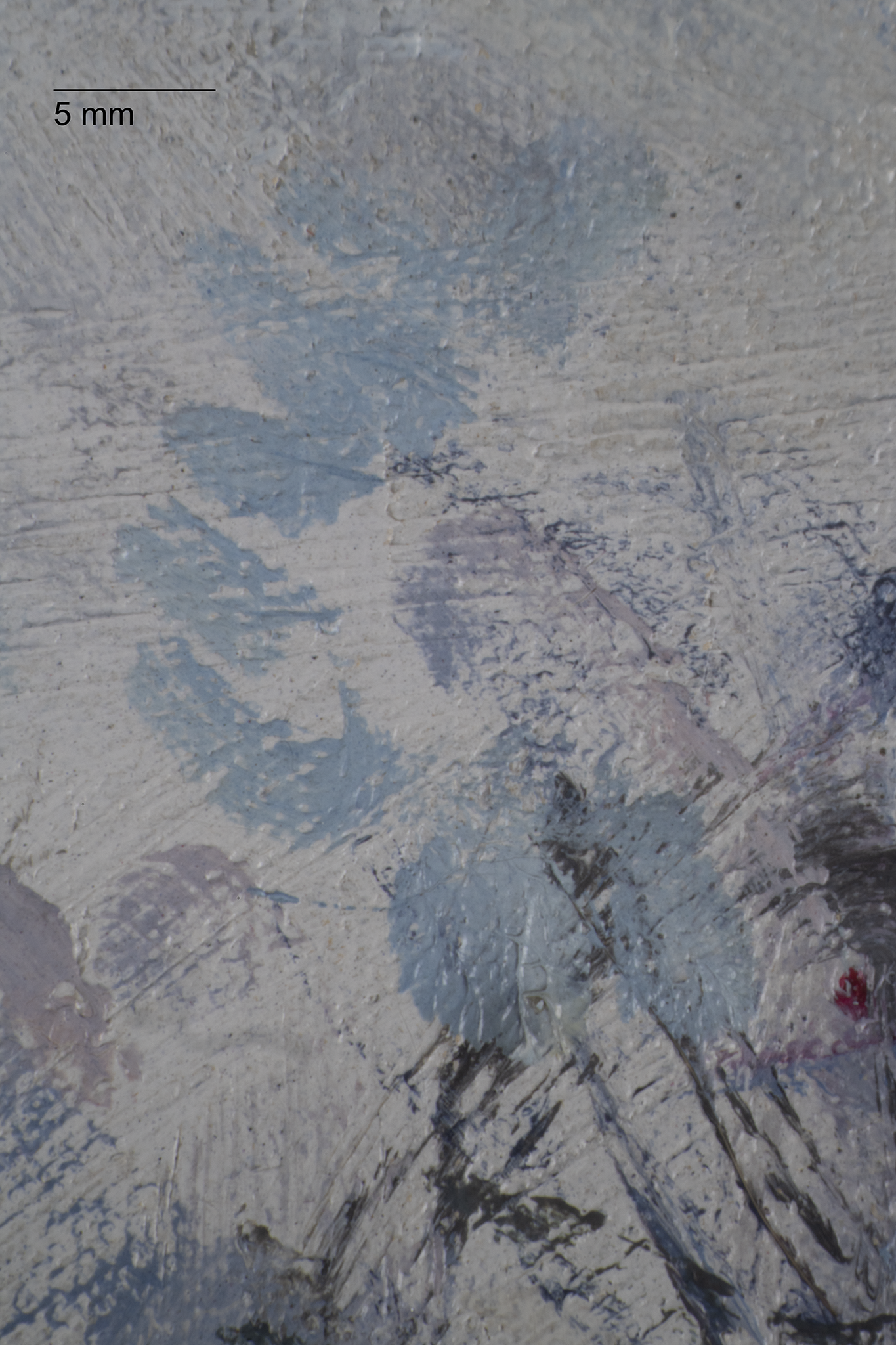 Fig. 11. Photomicrograph of blue brushstrokes on foreground tree, illustrating wet-over-dry application, Snow Effect at Argenteuil (1875; 44-41/3)
Fig. 11. Photomicrograph of blue brushstrokes on foreground tree, illustrating wet-over-dry application, Snow Effect at Argenteuil (1875; 44-41/3)
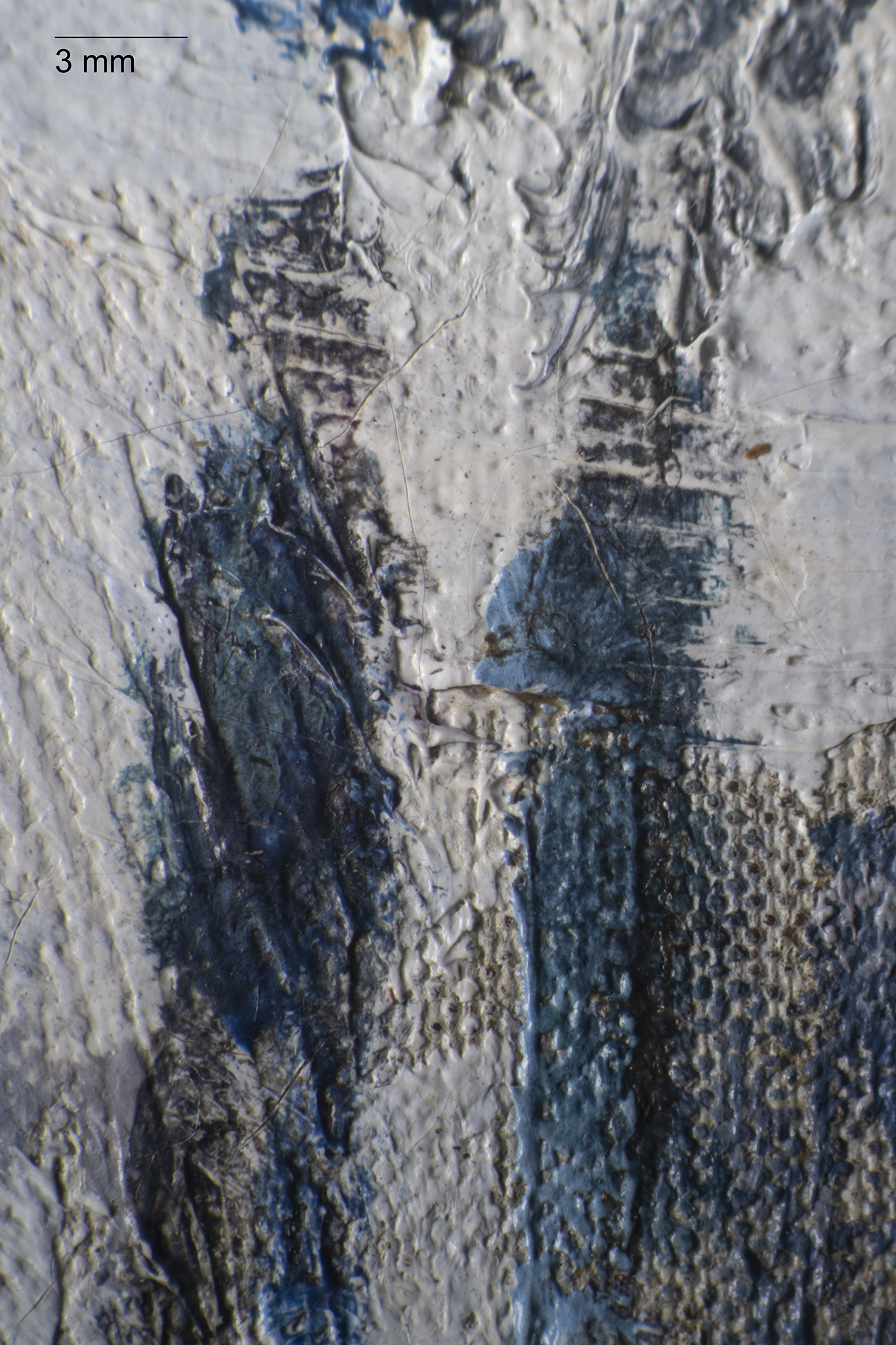 Fig. 12. Photomicrograph in raking light revealing texture of the lower paint layer under the figures and application of figures wet-over-dry, Snow Effect at Argenteuil (1875; 44-41/3)
Fig. 12. Photomicrograph in raking light revealing texture of the lower paint layer under the figures and application of figures wet-over-dry, Snow Effect at Argenteuil (1875; 44-41/3)
The foreground and near middle ground figures were added to the still wet path, with their brushstrokes pressing in and displacing the paint beneath. The distant figures near the fork in the path were painted in a later session, incorporating the texture of the already dried path (Fig. 12).10Later in his career, Monet incorporated the texture of the underlying paint layer to a much greater extent. For a discussion on this later technique, see Robert Herbert, “Method and Meaning in Monet,” Art in America 67, no. 5 (April 1979): 98-100. See also Kirsh and Levenson, Seeing Through Paintings: Physical Examination in Art Historical Studies, 139. In all instances, the figures are little more than silhouettes, with well-placed dabs of orange to signify the faces of the two rightmost figures (Fig. 13).
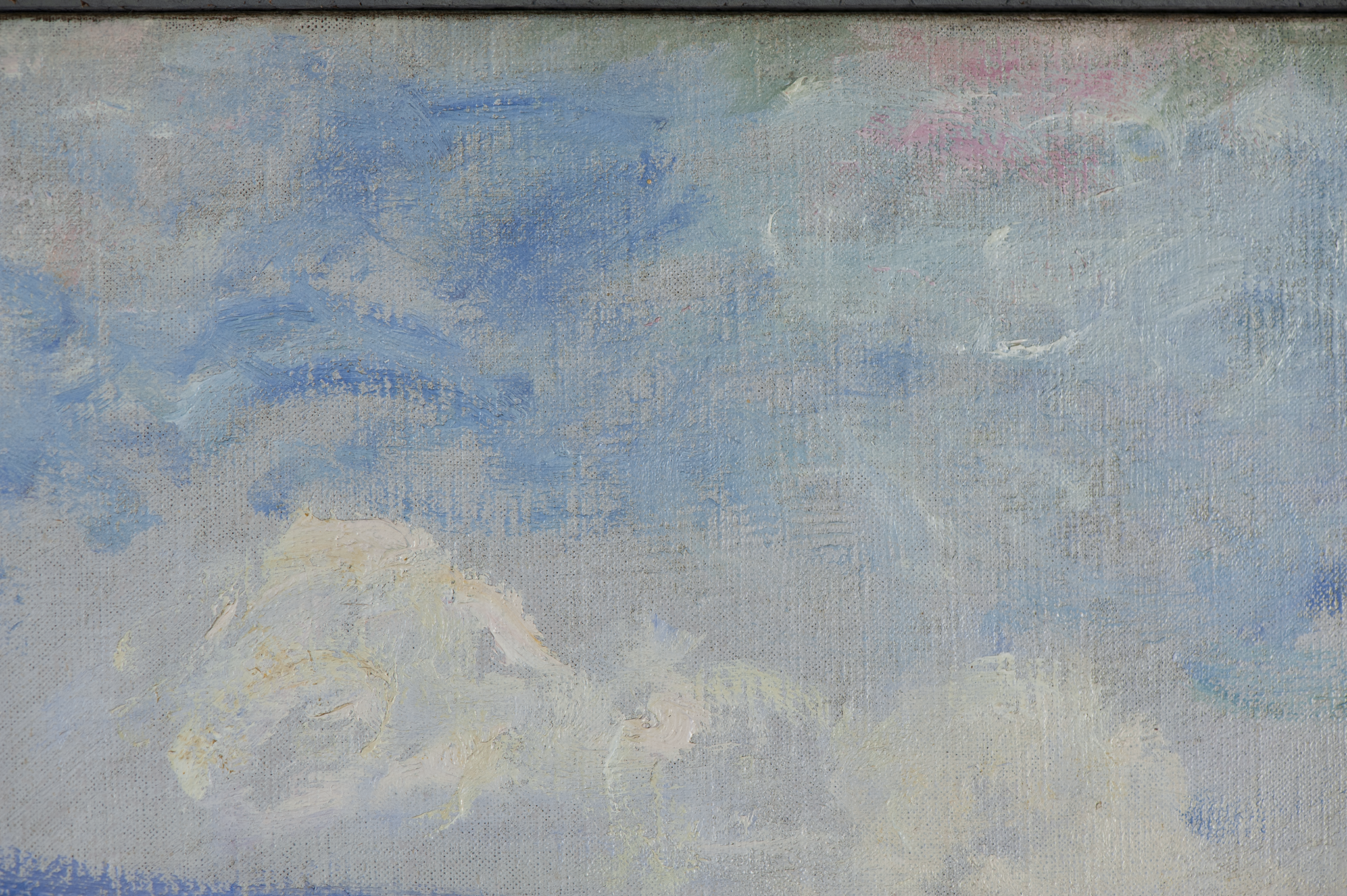 Fig. 14. Detail of the clouds with the exposed gray-blue underlayer, Snow Effect at Argenteuil (1875; 44-41/3)
Fig. 14. Detail of the clouds with the exposed gray-blue underlayer, Snow Effect at Argenteuil (1875; 44-41/3)
 Fig. 15. Ultraviolet-induced visible fluorescence photograph. Broad areas of “army green” indicate overpaint (outlined in green), Snow Effect at Argenteuil (1875; 44-41/3)
Fig. 15. Ultraviolet-induced visible fluorescence photograph. Broad areas of “army green” indicate overpaint (outlined in green), Snow Effect at Argenteuil (1875; 44-41/3)
The painting has undergone numerous restoration and conservation treatments. The canvas was lined in 1976 to stabilize the tacking margins,11Forrest R. Bailey, January 22, 1976, treatment report, Nelson-Atkins conservation file, no. 44/41-3. and a synthetic varnish was removed in 2006.12Mary Schafer, October 27, 2006, treatment report, Nelson-Atkins conservation file, no. 44/41-3. During the 1976 examination it became evident that regions of the painting had been reworked prior to the painting’s history at the Nelson-Atkins Museum of Art. Aged overpaintoverpaint: Restoration paint that covers original paint that may or may not be damaged. Historically, overpaint has often been applied too broadly, altering the intended aesthetic of the painting and sometimes introducing conceptions foreign to the original artist, thereby altering our understanding of the work and the era to which it belongs., applied with broad, painterly brushstrokes, is readily visible throughout the composition based upon its dull green ultraviolet-induced fluorescenceultraviolet (UV) fluorescence or UV-induced visible fluorescence: The reflected visible light produced when painting materials interact with ultraviolet (UV) radiation. Not all materials fluoresce, but the color and intensity of the fluorescence is frequently used to differentiate between original and restoration materials, characterize the varnish layers, or reveal the distribution of pigments across the composition. (Fig. 15). When examining the painting under a microscope, this paint appears heavily bodied but translucent, somewhat like a glazeglaze: A transparent, oil or resin-rich paint application that influences the tonality of the underlying paint.. Monet, however, was known for his use of opaque paints and general lack of glazes.13Previous technical studies have found that Monet predominantly applied opaque paints rather than glazes used in traditional painting methods. Michael Wilson, Martin Wyld, and Ashok Roy, “Monet’s ‘Bathers at Le Grenouillere’,” National Gallery Technical Bulletin 5, (1981): 19. Strangely, in many places, the underlying original paint appears healthy making it unclear why this overpaint was added. Within the right fence line, some of the translucent brown posts appear to have been reinforced or added during this campaign.14Paint is visible in age cracks found throughout these posts indicating it was added after the painting had aged enough to form cracks. The overpaint appears to have discolored and aged differently from the original paint, indicating it was likely added by another hand after the painting was completed. However, as this painting was in the possession of Monet’s dealer, Paul Durand-Ruel, for over twenty years after its completion, it cannot be absolutely stated that these are not artist additions or alterations dating from between 1875, when it was purchased by Durand-Ruel, to 1896, when it left Durand-Ruel et Cie and arrived in Kansas City.15Durand-Ruel sold the painting to his gallery in 1891. See accompanying essay by Stevenson.
Notes
-
The Ottoz family had a long tradition as suppliers to artists, from 1827 to 1890. Alexis Ottoz was located at “Rue 46 Notre Dame de Lorette” from 1867 to 1875 and also worked as a painting restorer and dealer. Considering the dates at this location, the date of this painting, and the known provenance, it is likely that the stamp reflects Monet’s canvas purchase rather than a restoration or sale. Pascal Labreuche, “La maison Alexis Ottoz,” Bulletin de la Société des Amis de Jongkind (1819–1891), no. 45A, (December 31, 2014): 51.
-
David Bomford, Jo Kirby, John Leighton, and Ashok Roy, Art in the Making: Impressionism (London: Yale University Press, 1991), 46.
-
While tinted grounds became common for Monet by the 1870s, white grounds were commonly used by the Impressionists to increase luminosity. Anthea Callen, The Art of Impressionism: Painting Technique and the Making of Modernity (New Haven: Yale University Press, 2000), 70. See also Anthea Callen, Techniques of the Impressionists (London: Tiger Books International, 1990), 55.
-
Later in life Monet returned to using canvas with white ground layers. Bomford et al., Art in the Making: Impressionism, 89.
-
See the accompanying catalogue entry by Glynnis Napier Stevenson.
-
For an overview of Monet’s paint handling during this period, see John House, Monet: Nature into Art (New Haven: Yale University Press, 1986), 75–83.
-
Bomford et al., Art in the Making: Impressionism, 27, 91. See also Andrea Kirsh and Rustin S. Levenson, Seeing Through Paintings: Physical Examination in Art Historical Studies (New Haven: Yale University Press, 2000), 123.
-
Boulevard des Capucines (1873–1874; The Nelson-Atkins Museum of Art) was painted looking out from Nadar’s studio. Ian Kennedy, “Monet’s Boulevard des Capucines: Kansas City or Moscow?,” Apollo: The International Magazine of Art and Antiques 165, no. 541 (2007): 69. For more information on the relationship between Monet and Nadar, see Aimee Marcereau DeGalan, “Claude Monet, Boulevard des Capucines, 1873—1874,” catalogue entry in ed. Aimee Marcereau DeGalan French Paintings and Pastels, 1600–1945: The Collections of the Nelson-Atkins Museum of Art (Kansas City: The Nelson-Atkins Museum of Art, 2021), https://doi.org/10.37764/78973.5.626.5407.
-
This is in comparison to Snow Effect at Argenteuil (1875; The Nelson-Atkins Museum of Art, 2015.13.14) which was painted en plein air and has predominantly wet-over-wet paint application.
-
Later in his career, Monet incorporated the texture of the underlying paint layer to a much greater extent. For a discussion on this later technique, see Robert Herbert, “Method and Meaning in Monet,” Art in America 67, no. 5 (April 1979): 98–100. See also Kirsh and Levenson, Seeing Through Paintings: Physical Examination in Art Historical Studies, 139.
-
Forrest R. Bailey, January 22, 1976, treatment report, Nelson-Atkins conservation file, no. 44/41-3.
-
Mary Schafer, October 27, 2006, treatment report, Nelson-Atkins conservation file, no. 44/41-3.
-
Previous technical studies have found that Monet predominantly applied opaque paints rather than glazes used in traditional painting methods. Michael Wilson, Martin Wyld, and Ashok Roy, “Monet’s ‘Bathers at Le Grenouillere’,” National Gallery Technical Bulletin 5, (1981): 19.
-
Paint is visible in age cracks found throughout these posts indicating it was added after the painting had aged enough to form cracks.
-
Durand-Ruel sold the painting to his gallery in 1891. See accompanying essay by Stevenson.
Documentation
Citation
Chicago:
Glynnis Napier Stevenson, “Claude Monet, Snow Effect at Argenteuil, 1875 (44-41/3),” documentation in ed. Aimee Marcereau DeGalan French Paintings and Pastels, 1600–1945: The Collections of the Nelson-Atkins Museum of Art (Kansas City: The Nelson-Atkins Museum of Art, 2021), https://doi.org/10.37764/78973.5.628.4033.
MLA:
Stevenson, Glynnis Napier. “Claude Monet, Snow Effect at Argenteuil, 1875 (44-41/3),” documentation. French Paintings and Pastels, 1600–1945: The Collections of the Nelson-Atkins Museum of Art, edited by Aimee Marcereau DeGalan, The Nelson-Atkins Museum of Art, 2021. doi: 10.37764/78973.5.628.4033
Provenance
Citation
Chicago:
Glynnis Napier Stevenson, “Claude Monet, Snow Effect at Argenteuil, 1875 (44-41/3),” documentation in ed. Aimee Marcereau DeGalan French Paintings and Pastels, 1600–1945: The Collections of the Nelson-Atkins Museum of Art (Kansas City: The Nelson-Atkins Museum of Art, 2021), https://doi.org/10.37764/78973.5.628.4033.
MLA:
Stevenson, Glynnis Napier. “Claude Monet, Snow Effect at Argenteuil, 1875 (44-41/3),” documentation. French Paintings and Pastels, 1600–1945: The Collections of the Nelson-Atkins Museum of Art, edited by Aimee Marcereau DeGalan, The Nelson-Atkins Museum of Art, 2021. doi: 10.37764/78973.5.628.4033.
Probably purchased from the artist at his sale, Tableaux et Aquarelles par Claude Monet, Berthe Morisot, A. Renoir, A. Sisley, Hôtel Drouot, Paris, March 24, 1875, lot 2, as effet de neige, by Paul Durand-Ruel (1831–1922), Paris, 1875–August 25, 1891 [1];
Purchased from Paul Durand-Ruel, Paris, by Durand-Ruel et Cie, Paris, stock no. 1323, as Argenteuil, effet de neige, 1891–May 21, 1896 [2];
Purchased from Durand-Ruel, Paris, by William Rockhill Nelson (1841–1915), Kansas City, MO, May 21, 1896–April 13, 1915;
To his wife, Ida Nelson (née Houston, 1853–1921), Kansas City, MO, 1915–October 6, 1921;
By descent to her daughter, Laura Kirkwood (née Nelson, 1883–1926), Kansas City, MO, 1921–February 27, 1926;
Inherited by her husband, Irwin Kirkwood (1878–1927), Kansas City, MO, 1926–August 29, 1927;
Laura Nelson Kirkwood Residuary Trust, Kansas City, MO, 1927–June 27, 1944 [3];
Gift of the Laura Nelson Kirkwood Residuary Trust to The Nelson-Atkins Museum of Art, Kansas City, MO, 1944.
Notes
[1] It is very likely that Paul Durand-Ruel purchased this painting from Claude Monet at his March 24, 1875 sale, where he is listed as the purchaser of three other Argenteuil snow scenes. See Merete Bodelsen, “Early Impressionist Sales 1874–94 in the light of some unpublished ‘procès-verbaux’,” Burlington Magazine 110, no. 783 (June 1968): 333, 335. If that is the case, then the painting was probably in the Fourth Impressionist Exhibition, as cat. no. 159, Effet de neige (1875) à Argenteuil, which was lent by M. Durand-Ruel. See Catalogue de la 4me Exposition de peinture par M. Bracquemond–Mme Bracquemond—M. Caillebotte—M. Cals—Mlle Cassatt—MM. Degas—Forain—Lebourg—Monet—Pissarro—Feu Piette—Rouart—H. Somm—Tillot et Zandomenighi, 28 Avenue de l’opéra, Paris, April 10–May 11, 1879.
[2] See email from Paul-Louis Durand-Ruel and Flavie Durand-Ruel, Durand-Ruel et Cie, Paris, to Nicole Myers, NAMA, January 11, 2016, NAMA curatorial file.
[3] As early as 1927, art advisor to the NAMA trustees, R. A. Holland, noted the painting in the contents of Oak Hall, Nelson’s mansion, as one to keep for the budding museum’s collection. Letter from Fred C. Vincent, Laura Nelson Kirkwood Trustee, to Herbert V. Jones, NAMA Trustee, December 28, 1927, NAMA curatorial files. However, the painting was not given to the museum until Laura Nelson Kirkwood’s household goods and personal effects were finally dispersed in 1944.
Exhibitions
Citation
Chicago:
Glynnis Napier Stevenson, “Claude Monet, Snow Effect at Argenteuil, 1875 (44-41/3),” documentation in ed. Aimee Marcereau DeGalan French Paintings and Pastels, 1600–1945: The Collections of the Nelson-Atkins Museum of Art (Kansas City: The Nelson-Atkins Museum of Art, 2021), https://doi.org/10.37764/78973.5.628.4033.
MLA:
Stevenson, Glynnis Napier. “Claude Monet, Snow Effect at Argenteuil, 1875 (44-41/3),” documentation. French Paintings and Pastels, 1600–1945: The Collections of the Nelson-Atkins Museum of Art, edited by Aimee Marcereau DeGalan, The Nelson-Atkins Museum of Art, 2021. doi: 10.37764/78973.5.628.4033.
Probably 4me Exposition de peinture par M. Bracquemond–Mme Bracquemond—M. Caillebotte—M. Cals—Mlle Cassatt—MM. Degas—Forain—Lebourg—Monet—Pissarro—Feu Piette—Rouart—H. Somm—Tillot et Zandomenighi, 28 avenue de l’Opéra, Paris, April 10–May 11, 1879, no. 159, as Effet de neige (1875) à Argenteuil.
Haagsche Kunstkring; Tentoonstelling van schilderijen en beeldhouwwerken van werkende leden der 1ste afdeeling en van werken van Claude Monet, Renoir, Sisley en C. Pissarro, The Hague, The Netherlands, October 8–November 6, 1893, no. 46, as Argenteuil (effet de neige.).
Exposition triennale de Beaux-arts de Gand 1895, Ghent, Belgium, September 1–October 28, 1895, no. 449, as Argenteuil. Effet de neige.
Oak Hall Exhibition, Oak Hall, Kansas City, MO, October 5–9, 1927, no cat., as Silvered Effect of Snow.
Memorial Exhibition of the Paintings from the Laura Nelson Kirkwood Collection, The Nelson-Atkins Museum of Arts, Kansas City, MO, opened November 18, 1934, no cat.
Masterpiece of the Month, The Nelson-Atkins Museum of Arts, Kansas City, MO, October 1937, as View of Argentueille [sic].
Fine Arts Festival, Allyn Art Gallery, Southern Illinois University, Carbondale, IL, February 26–March 10, 1956, no. 10, as View of Argentueille [sic] and View of Argentueil.
Impressionist Paintings, Roberson Center for the Arts and Sciences, Binghamton, NY, October 21–November 18, 1956, no cat.
“One Hundred Years of Impressionism:” A Tribute to Durand-Ruel; A Loan Exhibition For the Benefit of the New York University Art Collection, Wildenstein, New York, April 2–May 9, 1970, no. 34, as Vue d’Argenteuil, Neige.
City Views, The Nelson-Atkins Museum of Art, Kansas City, MO, May 31–July 10, 1983, no. 38B, as View of Argenteuil.
Impressionism: Selections From Five American Museums, The Carnegie Museum of Art, Pittsburgh, November 4–December 31, 1989; The Minneapolis Institute of Arts, January 27–March 25, 1990; The Nelson-Atkins Museum of Art, Kansas City, MO, April 21–June 17, 1990; Saint Louis Art Museum, July 14–September 9, 1990; The Toledo Museum of Art, OH, September 30–November 25, 1990, no. 50, as View of Argenteuil, Snow.
Claude Monet, Musée d’art moderne, Liège, Belgium, March 12–May 31, 1992, no. 5, as Vue d’Argenteuil, sous la neige.
Impressionists in Winter: Effets de Neige, The Phillips Collection, Washington, DC, September 19, 1998–January 3, 1999; Yerba Buena Center for the Arts, San Francisco, January 30–May 2, 1999, no. 10, as View of Argenteuil—Snow.
Monet and Japan, National Gallery of Australia, Canberra, March 9–June 11, 2001; Art Gallery of Western Australia, Perth, July 7–September 16, 2001, no. 9, as View of Argenteuil, snow.
Gli impressionisti e la neve: La Francia e l’Europa, Promotrice delle Belle Arti, Turin, Italy, November 27, 2004–April 25, 2005, no. 118, as Veduta di Argenteuil, neve.
References
Citation
Chicago:
Glynnis Napier Stevenson, “Claude Monet, Snow Effect at Argenteuil, 1875 (44-41/3),” documentation in ed. Aimee Marcereau DeGalan French Paintings and Pastels, 1600–1945: The Collections of the Nelson-Atkins Museum of Art (Kansas City: The Nelson-Atkins Museum of Art, 2021), https://doi.org/10.37764/78973.5.628.4033.
MLA:
Stevenson, Glynnis Napier. “Claude Monet, Snow Effect at Argenteuil, 1875 (44-41/3),” documentation. French Paintings and Pastels, 1600–1945: The Collections of the Nelson-Atkins Museum of Art, edited by Aimee Marcereau DeGalan, The Nelson-Atkins Museum of Art, 2021. doi: 10.37764/78973.5.628.4033.
Probably Catalogue des Tableaux et aquarelles par Claude Monet, Berthe Morisot, A. Renoir, A. Sisley (Paris: Hôtel Drouot, March 24, 1875), 7, as Effet de neige.
Probably Catalogue de la 4me Exposition de peinture par M. Bracquemond–Mme Bracquemond—M. Caillebotte—M. Cals—Mlle Cassatt—MM. Degas—Forain—Lebourg—Monet—Pissarro—Feu Piette—Rouart—H. Somm—Tillot et Zandomenighi, exh. cat. (Paris: Morris, père et fils, imprimerie, 1879), 12 [repr., in Theodore Reff, ed., Modern Art in Paris: Two-Hundred Catalogues of the Major Exhibitions Reproduced in Facsimile in Forty-Seven Volumes, vol. 23, Impressionist Group Exhibitions (New York: Garland, 1981), unpaginated], as Effet de neige (1875) à Argenteuil.
Haagse Kunstkring; Tentoonstelling van schilderijen en beeldhouwwerken van werkende leden der 1ste afdeeling en van werken van Claude Monet, Renoir, Sisley en C. Pissarro, exh. cat. (The Hague, The Netherlands: Mouton, 1893), 7, as Argenteuil (effet de neige).
Exposition triennale de Beaux-arts de Gand 1895, exh. cat. (Ghent, Belgium: Salon de Gand, 1895), 95, as Argenteuil. Effet de neige.
Possibly Gustave Geffroy, Claude Monet, sa vie, son œuvre, vol. 1 (Paris: Les Éditions G. Crès et Cie, 1924), 156, 213.
“Laura Nelson-Kirkwood,” Kansas City Star 46, no. 164 (February 28, 1926): 1A.
“Oak Hall Open Wednesday,” Kansas City Star 48, no. 15 (October 2, 1927): 2A, as Silvered Effect of Snow.
Possibly Paul V. Beckley, “Art News,” Kansas City Journal-Post, no. 193 (December 17, 1933): 2C.
“Art,” Kansas City Star 55, no. 62 (November 18, 1934): 12A.
“Special Lecture Announcement,” News Flashes 1, no. 3 (The William Rockhill Nelson Gallery of Art and Atkins Museum of Fine Arts) (November 18–December 1, 1934): 1.
M[inna] K. P[owell], “Art: Paintings from Oak Hall Viewed by Public for First Time—A Large Ribera, Several Interesting Dutch Canvases, Portraits of the English School and a Few French Moderns Are Shown,” Kansas City Times 97, no. 277 (November 19, 1934): 8.
“Masterpiece of the Month,” News Flashes (The William Rockhill Nelson Gallery of Art and Atkins Museum of Fine Arts) 3, no. 10 (October 1, 1937): 2, as View of Argenteuil.
M[inna] K. P[owell], “In Gallery and Studio: News and Views of the Week in Art,” Kansas City Star 58, no. 14 (October 1, 1937): 26, as View of Argenteuill [sic] and View of Argenteuil.
“Nelson Gallery Masterpiece of Month,” Kansas City Journal-Post, no. 11 (October 3, 1937): 3B, (repro.), as View of Argenteuil.
“Music and Musicians: Concerts for Clubs,” Kansas City Star 64, no. 205 (April 9, 1944): 15C.
Fine Arts Festival, exh. cat. (Carbondale, IL: Southern Illinois University, 1956), unpaginated, as View of Argentueille [sic].
Ross E. Taggart, “Kansas City Art,” Library Journal 82, no. 12 (June 15, 1957): 1596.
Henry C. Haskell, “Scanning the Arts,” Kansas City Star 85, no. 157 (February 21, 1965): 1D.
Probably Merete Bodelsen, “Early Impressionist Sales 1874–94 in the light of some unpublished ‘procès-verbaux’,” The Burlington Magazine 110, no. 783 (June 1968): 333, 335, as Effet de neige.
“One Hundred Years of Impressionism:” A Tribute to Durand-Ruel; A Loan Exhibition For the Benefit of the New York University Art Collection, exh. cat. (New York: Wildenstein, 1970), unpaginated, (repro.), as Vue d’Argenteuil, Neige.
Donald Hoffmann, “A Beautiful Monet is Acquired By Nelson Gallery,” Sunday Star Magazine of the Kansas City Star, supplement, Kansas City Star 93, no. 126 (January 21, 1973): S12, as View of Argenteuil.
Ross E. Taggart and George L. McKenna, eds., Handbook of the Collections in The William Rockhill Nelson Gallery of Art and Mary Atkins Museum of Fine Arts, Kansas City, Missouri, vol. 1, Art of the Occident, 5th ed. (Kansas City, MO: William Rockhill Nelson Gallery of Art and Mary Atkins Museum of Fine Arts, 1973), 162, 258, (repro.), as View of Argenteuil.
Henry C. Haskell, “Gallery Rules and Later Gifts: Nelson Had His Reasons,” Kansas City Star 94, no. 118 (January 13, 1974): E1.
Daniel Wildenstein, Claude Monet: Biographie et catalogue raisonné, vol. 1, 1840–1881: Peintures (Lausanne: La Bibliothèque des Arts, 1974), no. 358, pp. 266–67, 452, 460, (repro.), as Vue d’Argenteuil, neige.
Joel Isaacson, Claude Monet: Observation and Reflection (Oxford: Phaidon, 1978), 20, 97, 207, (repro.), as View of Argenteuil, Snow and Vue d’Argenteuil, neige.
Robert H. Terte, “The Phenomenal Nelson Gallery,” Antiques World 1, no. 3 (January 1979): 46.
John M. Merriman, ed., French Cities in the Nineteenth Century (New York: Holmes and Meier, 1981), 155, 269n14, as View of Argenteuil, Winter.
Ross E. Taggart and Roger B. Ward, City Views, exh. cat. (Kansas City, MO: Nelson-Atkins Museum of Art, 1983), 14, as View of Argenteuil.
T. J. Clark, The Painting of Modern Life: Paris in the Art of Manet and His Followers (New York: Alfred A. Knopf, 1984), x, 194, 303n51, as Vue d’Argenteuil, neige.
“Education Insights: Lunch Break. The Impressionist Landscape,” Calendar of Events (The Nelson-Atkins Museum of Art) (June 1985): unpaginated, as View of Argenteuil.
Probably Charles S. Moffett, The New Painting: Impressionism 1874–1886, exh. cat. (Geneva: Richard Burton SA, 1986), 259, 269, as Effet de neige (1875) à Argenteuil.
“Museums to Sports, KC Has It All,” American Water Works Association Journal 79, no. 4 (April 1987): 133.
Donald Hoffmann, “Out of the dark and into the light: Pissarro landscape ‘found’ at Nelson,” Kansas City Star 109, no. 7 (September 25, 1988): 1D, as View of Argenteuil.
“New at the Nelson: Museum ‘Discovers’ Pissarro Painting,” Calendar of Events (The Nelson-Atkins Museum of Art) (October 1988): 2, as View of Argenteuil, Snow.
Marc S. Gerstein, Impressionism: Selections from Five American Museums, exh. cat. (New York: Hudson Hills, 1989), 12, 36, 90, 122, 123, 178, (repro.), as View of Argenteuil, Snow.
Toni Wood, “The impressionists broke all the rules: Modern viewers love impressionism,” Kansas City Star 110, no. 184 (April 15, 1990): H4, as View of Argenteuil, Snow.
Toni Wood, “Expatriate paintings in Midwest: Works took diverse routes to exhibit,” Kansas City Star 110, no. 233 (June 3, 1990): G5, as View of Argenteuil, Snow.
Daniel Wildenstein, Claude Monet: Catalogue raisonné, vol. 5, Supplément aux peintures, dessins, pastels, index (Lausanne: Wildenstein Institute, 1991), no. 358, pp. 29, 292, 330, 333, 335, as Vue d’Argenteuil, Neige.
John Dixon Hunt, Gardens and the Picturesque: Studies in the History of Landscape Architecture (Cambridge, MA: MIT Press, 1992), xiii, 254–55, (repro.), as View of Argenteuil (from the Artist’s Rented House).
Françoise Dumont, ed., Liège 92: Claude Monet, exh. cat. (Liège, Belgium: Salle Saint-Georges, 1992), 58–59, 132, (repro.), as Vue d’Argenteuil, sous la neige.
Sandro Sproccati, Monet (Edison, NJ: Chartwell Books, 1992), 117, (repro.), as View of Argenteuil, Snow, Argenteuil, January or February 1875.
Michael Churchman and Scott Erbes, High Ideals and Aspirations: The Nelson-Atkins Museum of Art 1933–1993 (Kansas City, MO: Nelson-Atkins Museum of Art, 1993), 23, 34n1, as View of Argenteuil—Snow.
Bernard Denvir, The Chronicle of Impressionism: An Intimate Diary of the Lives and World of the Great Artists (London: Thames and Hudson, 1993), 279.
Roger Ward and Patricia J. Fidler, eds., The Nelson-Atkins Museum of Art: A Handbook of the Collection (New York: Hudson Hills, 1993), 12, as View of Argenteuil, Snow.
Kristie C. Wolferman, The Nelson-Atkins Museum of Art: Culture Comes to Kansas City (Columbia, MO: Columbia University of Missouri Press, 1993), 186–88, as View of Argenteuil, Snow.
Mary Anne Staniszewski, Believing is Seeing: Creating the Culture of Art (New York: Penguin, 1995), 183, (repro.), as View of Argenteuil, Snow.
“Music Teachers National Association National Convention, March 23–27, 1996, Kansas City, Missouri,” American Music Teacher 45, no. 4 (February–March 1996): 23.
Probably Ruth Berson, The New Painting, Impressionism, 1874–1886 (San Francisco: Fine Arts Museums of San Francisco, 1996), 1:206, 221, 2:115–16, 288, as Effet de neige (1875) à Argenteuil.
Daniel Wildenstein, Monet or The Triumph of Impressionism (Cologne: Benedikt Taschen Verlag GmbH, 1996), no. 358, pp. 114, 479.
Daniel Wildenstein, Monet, vol. 2, Catalogue Raisonné-Werkverzeichnis: Nos. 1–968 (Cologne: Benedikt Taschen Verlag GmbH, 1996), no. 358, p. 148, (repro.), as Vue d’Argenteuil, neige, View of Argenteuil, Snow, and Blick auf Argenteuil im Schnee.
“Behind the Scenes: Several European Paintings to Travel,” Newsletter (The Nelson-Atkins Museum of Art) (October 1997): 4, as View of Argenteuil Snow.
Alice Thorson, “Traveling treasures: Some gallery favorites to go on tour as Nelson gears up for expansion,” The Kansas City Star (December 13, 1997): E1, as View of Argenteuil Snow.
Charles S. Moffett et al., Impressionists in Winter: Effets de Neige, exh. cat. (Washington, DC: Phillips Collection, 1998), 32, 98–99, 102, 208, (repro.), as View of Argenteuil—Snow.
“Behind the Scenes: Museum’s European Paintings in Demand,” Newsletter (The Nelson-Atkins Museum of Art) (October 2000): 4, as View of Argenteuil: Snow.
Lynne Knight, Snow Effects: Poems on Impressionists in Winter (Concord, CA: Small Poetry, 2000), 20, (repro.), as View of Argenteuil, Snow.
Virginia Spate and Gary Hickey, Monet and Japan, exh. cat. (Canberra: National Gallery of Australia, 2001), 23, 86, 195, (repro.), as View of Argenteuil, snow and Vue d’Argenteuil, neige.
Robert L. Herbert, From Monet to Léger: Essays in Social Art History (New Haven: Yale University Press, 2002), 13, 180n15, as View of Argenteuil, Winter.
Marco Goldin, Gli impressionisti e la neve: La Francia e l’Europa (Conegliano, Italy: Linea d’ombra Libri, 2004), 256, 288, 379–80, (repro.), as Veduta di Argenteuil, neve.
Mary Tompkins Lewis, ed., Critical Readings in Impressionism and Post-Impressionism: An Anthology (Berkeley: University of California Press, 2007), 133–34, 145n50, 344, (repro.), as View of Argenteuil—Snow.
Joseph Baillio, Claude Monet (1840–1926): A Tribute to Daniel Wildenstein and Katia Granoff, exh. cat. (New York: Wildenstein, 2007), 111, as Rue Saint-Denis: neige à Argenteuil.
Deborah Emont Scott, ed., The Nelson-Atkins Museum of Art: A Handbook of the Collection, 7th ed. (Kansas City, MO: Nelson-Atkins Museum of Art, 2008), 118, (repro.), as View of Argenteuil—Snow.
Mary Mathews Gedo, Monet and his Muse: Camille Monet in the Artist’s Life (Chicago: University of Chicago Press, 2010), 155.
Daniel Wildenstein, Monet or the Triumph of Impressionism (Cologne: Benedikt Taschen Verlag GmbH, 2010), no. 358, p. 114.
Alice Thorson, “Three Times the Wonder: Claude Monet’s later work reflects his obsession with the color and reflections in his water garden,” Kansas City Star Magazine, supplement, Kansas City Star 131, no. 198 (April 3, 2011): S9, as View of Argenteuil-Snow.
Possibly Jean-François Demeure, Monet en Creuse: Le printemps d’une méthode (Limoges, France: Éditions Culture et Patrimoine en Limousin, 2011), 38, as Effet de neige à Argenteuil.
Simon Kelly and April M. Watson, Impressionist France: Visions of Nation from Le Gray to Monet, exh. cat. (St. Louis, MO: St. Louis Art Museum, 2013), 47, 212, 241, (repro.), as View of Argenteuil—Snow.
Probably Paul-Louis Durand-Ruel and Flavie Durand-Ruel, eds., Paul Durand-Ruel: Memoirs of the First Impressionist Art Dealer (1831–1922) (Paris: Flammarion, 2014), 119, 266n131, as Effet de neige.
Nina Siegal, “Upon Closer Review, Credit Goes to Bosch,” New York Times 165, no. 57130 (February 2, 2016): C5.
“Nelson-Atkins to unveil renovated Bloch Galleries of European Art in winter 2017,” artdaily.org (July 20, 2016): unpaginated.
Catherine Futter et al., Bloch Galleries: Highlights from the Collection of the Nelson-Atkins Museum of Art (Kansas City, MO: Nelson-Atkins Museum of Art, 2016), 60, (repro.), as View of Argenteuil—Snow.
Ross King, Mad Enchantment: Claude Monet and the Painting of the Water Lilies (New York: Bloomsbury, 2016), 120.
Menachem Wecker, “Jewish Philanthropist Establishes Kansas City as Cultural Mecca,” The Forward (March 14, 2017): http://forward.com/culture/365264/jewish-philanthropist-establishes-kansas-city-as-cultural-mecca/ [repr., in Menachem Wecker, “Kansas City Collection Is A Chip Off the Old Bloch,” Forward (March 17, 2017): 20–22], as View of Argenteuil—Snow.
Richard Thomson, Monet and Architecture, exh. cat. (London: National Gallery Company, 2018), 218.
Claude Monet, Snow Effect at Argenteuil, 2015.13.14
Technical Entry
Citation
Chicago:
Diana M. Jaskierny, “Claude Monet, Snow Effect at Argenteuil, 1875 (2015.13.14),” technical entry in ed. Aimee Marcereau DeGalan French Paintings and Pastels, 1600–1945: The Collections of the Nelson-Atkins Museum of Art (Kansas City: The Nelson-Atkins Museum of Art, 2021), https://doi.org/10.37764/78973.5.629.2088.
MLA:
Jaskierny, Diana M. “Claude Monet, Snow Effect at Argenteuil, 1875 (2015.13.14),” technical entry. French Paintings and Pastels, 1600–1945: The Collections of the Nelson-Atkins Museum of Art, edited by Aimee Marcereau DeGalan, The Nelson-Atkins Museum of Art, 2021. doi: 10.37764/78973.5.629.2088.
Snow Effect at Argenteuil (20215.13.14) provides us with important information about the working style of Claude Monet and his use of materials, not only from the year this painting was completed, but also the years prior. Completed on fine-weave canvas, the painting corresponds with a standard-formatstandard-format supports: Commercially prepared supports available through art suppliers, which gained popularity in the nineteenth century during the industrialization of art materials. Available in three formats figure (portrait), paysage (landscape), and marine (marine), these were numbered 1 through 120 to indicate their size. For each numbered size, marine and paysage had two options available: a larger format (haute) and smaller (basse) format. no. 15 paysage, and likely retains its original size and format.1David Bomford, Jo Kirby, John Leighton, and Ashok Roy, Art in the Making: Impressionism (London: Yale University Press, 1991), 46. For more information on French canvas weaves, see also Anthea Callen, The Art of Impressionism: Painting Technique and the Making of Modernity (New Haven: Yale University Press, 2000), 31–32. Paper tape on all four tacking marginstacking margins: The outer edges of canvas that wrap around and are attached to the stretcher or strainer with tacks or staples. See also tacking edge. limits visibility; however, there is pronounced cuspingcusping: A scalloped pattern along the canvas edges that relates to how the canvas was stretched. Primary cusping reveals where tacks secured the canvas to the support while the ground layer was applied. Secondary cusping can form when a pre-primed canvas is re-stretched by the artist prior to painting. on at least the right and bottom margins.2Because of the paper tape, it is difficult to determine if cusping is present on the top and left tacking margins. The current stretcherstretcher: A wooden structure to which the painting’s canvas is attached. Unlike strainers, stretchers can be expanded slightly at the joints to improve canvas tension and avoid sagging due to humidity changes or aging., which was commercially planed and has mortise and tenon joins, appears to be original to the painting.
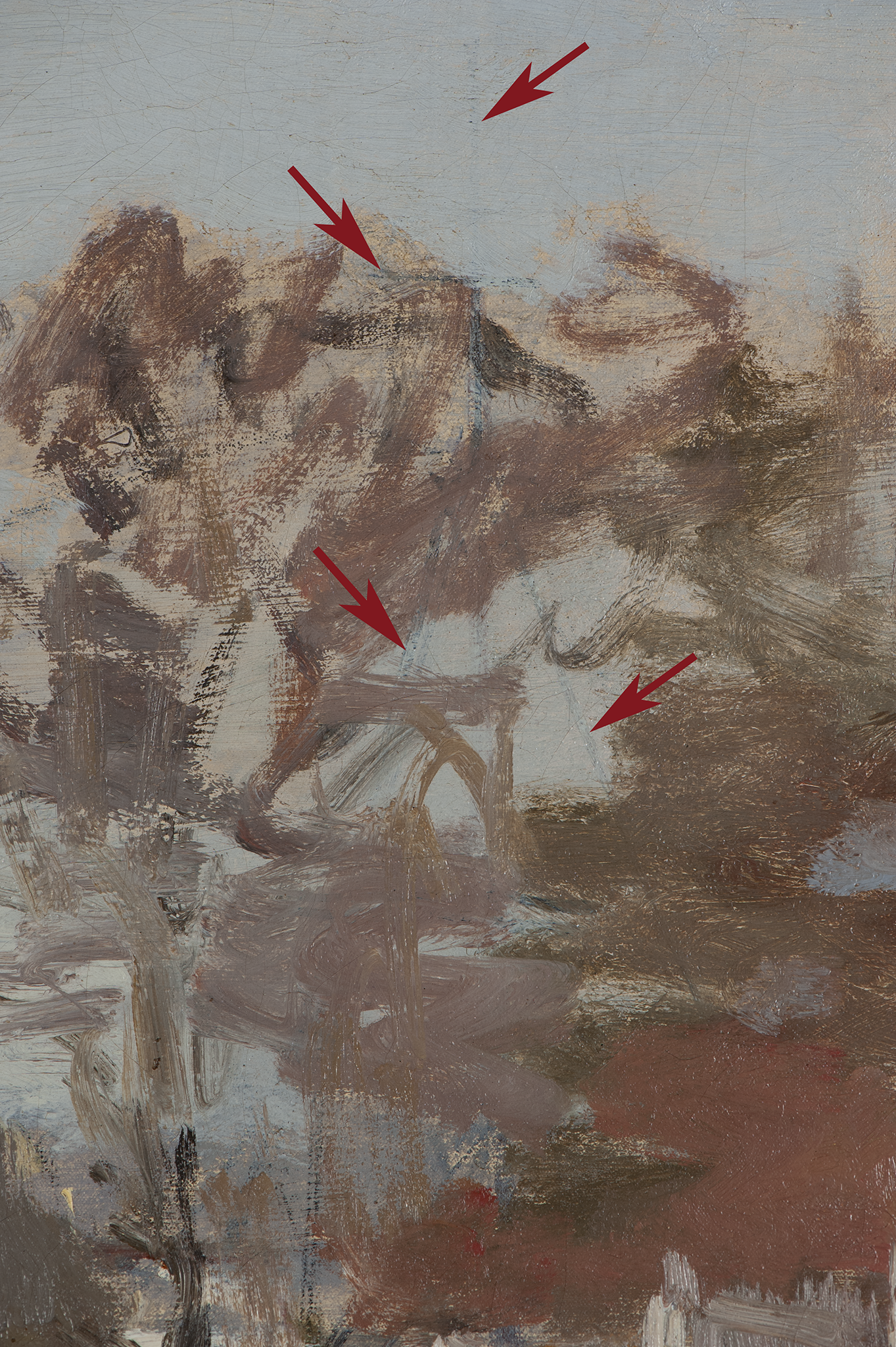 Fig. 17. Detail image of the pentimento found center-right, taken in standard viewing light, Snow Effect at Argenteuil (1875; 2015.13.14)
Fig. 17. Detail image of the pentimento found center-right, taken in standard viewing light, Snow Effect at Argenteuil (1875; 2015.13.14)
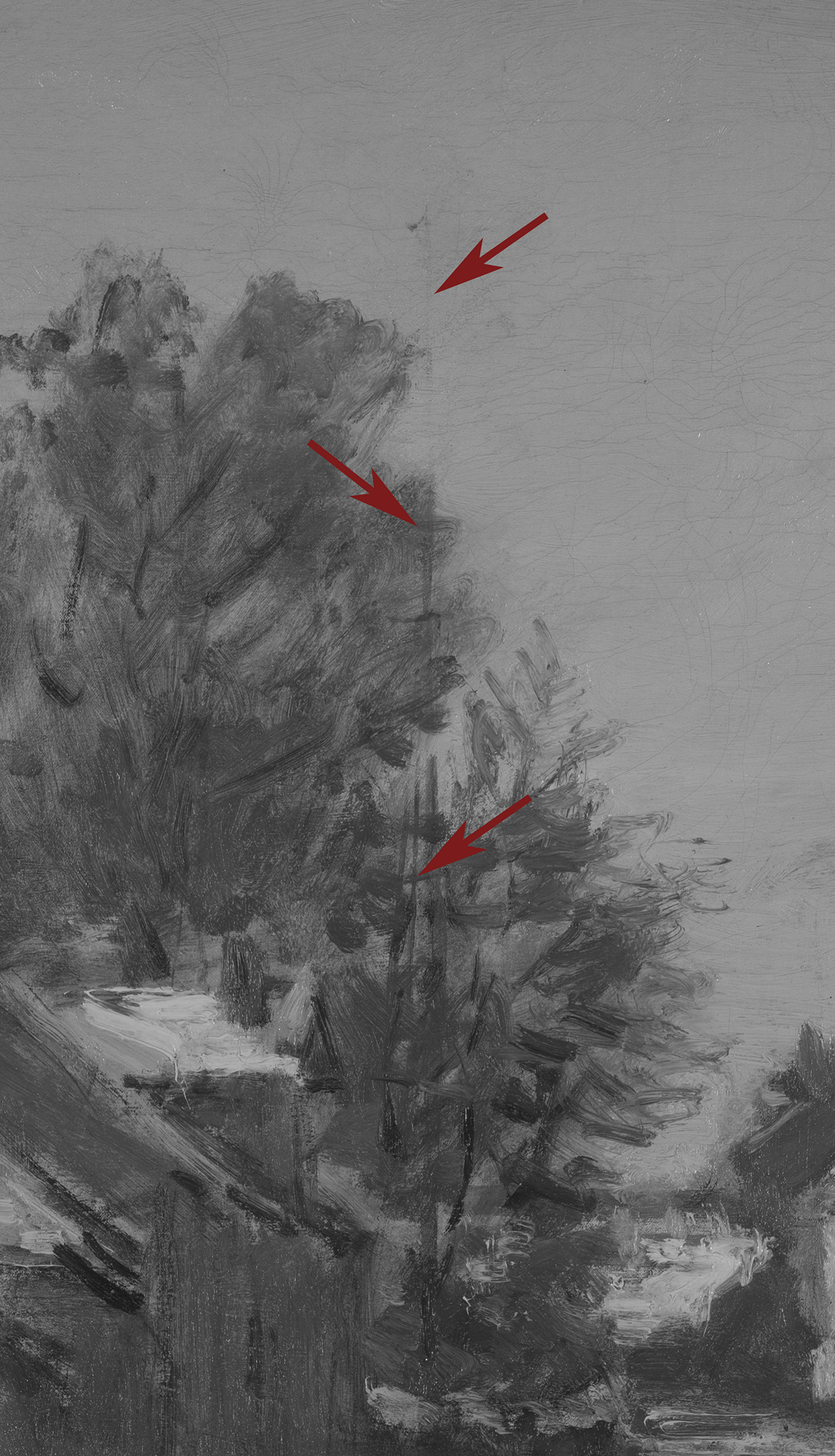 Fig. 18. Reflected infrared digital photograph detail of pentimento found among the left-side trees, Snow Effect at Argenteuil (1875; 2015.13.14)
Fig. 18. Reflected infrared digital photograph detail of pentimento found among the left-side trees, Snow Effect at Argenteuil (1875; 2015.13.14)
Pentimentipentimento (pl: pentimenti): A change to the composition made by the artist that is visible on the paint surface. Often with time, pentimenti become more visible as the upper layers of paint become more transparent with age. Italian for "repentance" or "a change of mind." found throughout the Nelson-Atkins painting reveal that Monet abandoned an earlier composition and reused the canvas. Within the trees on the right, there is a vertical structure beneath the paint layer, still visible in normal viewing light (Fig. 17). Through infrared reflectography (IRR)infrared reflectography (IRR): A form of infrared imaging that exploits the behavior of painting materials at wavelengths beyond those accessible to infrared photography. These advantages sometimes include a continuing increase in the transparency of pigments beyond wavelengths accessible to infrared photography (i.e, beyond 1,000 nanometers), rendering underdrawing more clearly. The resulting image is called an infrared reflectogram. Devices that came into common use in the 1980s such as the infrared vidicon effectively revealed these features but suffered from lack of sharpness and uneven response. Vidicons continue to be used out to 2,200 nanometers but several newer pixelated detectors including indium gallium arsenide and indium antimonide array detectors offer improvements. All of these devices are optimally used with filters constraining their response to those parts of the infrared spectrum that reveal the most within the constraints of the palette used for a given painting. They can be used for transmitted light imaging as well as in reflection., two additional vertical shapes were found: one near the right edge of the painting, and one in the center left, peeking out from behind the trees (Fig. 18). In all instances, these shapes are mostly covered with sky and landscape paint, though glimpses of them are visible between compositional elements.
When examining the painting under a microscope, it is clear that these structures were the first elements painted on the Nelson-Atkins version, directly on top of the ground layerground layer: An opaque preparatory layer applied to the support, either commercially or by the artist, to prevent absorption of the paint into the canvas or panel. See also priming layer., along with other shapes not clearly identifiable with a microscope or IRR. Consulting Monet’s oeuvre for the years prior to 1875 when this composition was completed, the vertical underlying shapes closely resemble his depictions of ship masts in maritime scenes. While it is unlikely the pentimenti in Snow Effect at Argenteuil directly correspond to a specific painting, of his completed and known maritime scenes the proportions and placements of these shapes echo masts in Ships in a Harbor (Fig. 19; about 1873; The Museum of Fine Arts, Boston).6From the mid-1860s to the mid-1870s, Monet moved frequently, often finding himself in port cities such as Honfleur and Le Havre. During this time, he painting many scenes of ships and shipyards, with Ships in a Harbor being one example. Monet: The Early Years (New Haven: Yale University Press, 2017), 71–77. Similar in size, though a different format,7The Museum of Fine Arts Boston painting Ships in a Harbor measures 49.8 x 61.0 centimeters, which roughly corresponds to a standard-format no. 12 portrait. “Ships in Harbor,” The Museum of Fine Arts Boston, accessed August 8, 2020, https://collections.mfa.org/objects/31270/ships-in-a-harbor?ctx=521deba2-9cf4-4795-84a9-c9560ca94b83&idx=5. See also Callen, The Art of Impressionism, 15. this scene portrays several large ships near one another and filling the canvas so that no view of a distant horizon or land is visible. The ships’ masts span half the height of the canvas or more, similar to the vertical shapes found beneath the paint layers of Snow Effect at Argenteuil.

 Fig. 21. Digital overlay of shapes detected on Snow Effect at Argenteuil (1875; 2015.13.14) in which blue lines indicate infrared reflectography and red lines indicate x-radiography, superimposed on a desaturated image of Ships in a Harbor (The Museum of Fine Arts, Boston; about 1873). This annotated image illustrates the similarities between the underlying composition of the Nelson-Atkins painting and Monet’s maritime paintings.
Fig. 21. Digital overlay of shapes detected on Snow Effect at Argenteuil (1875; 2015.13.14) in which blue lines indicate infrared reflectography and red lines indicate x-radiography, superimposed on a desaturated image of Ships in a Harbor (The Museum of Fine Arts, Boston; about 1873). This annotated image illustrates the similarities between the underlying composition of the Nelson-Atkins painting and Monet’s maritime paintings.
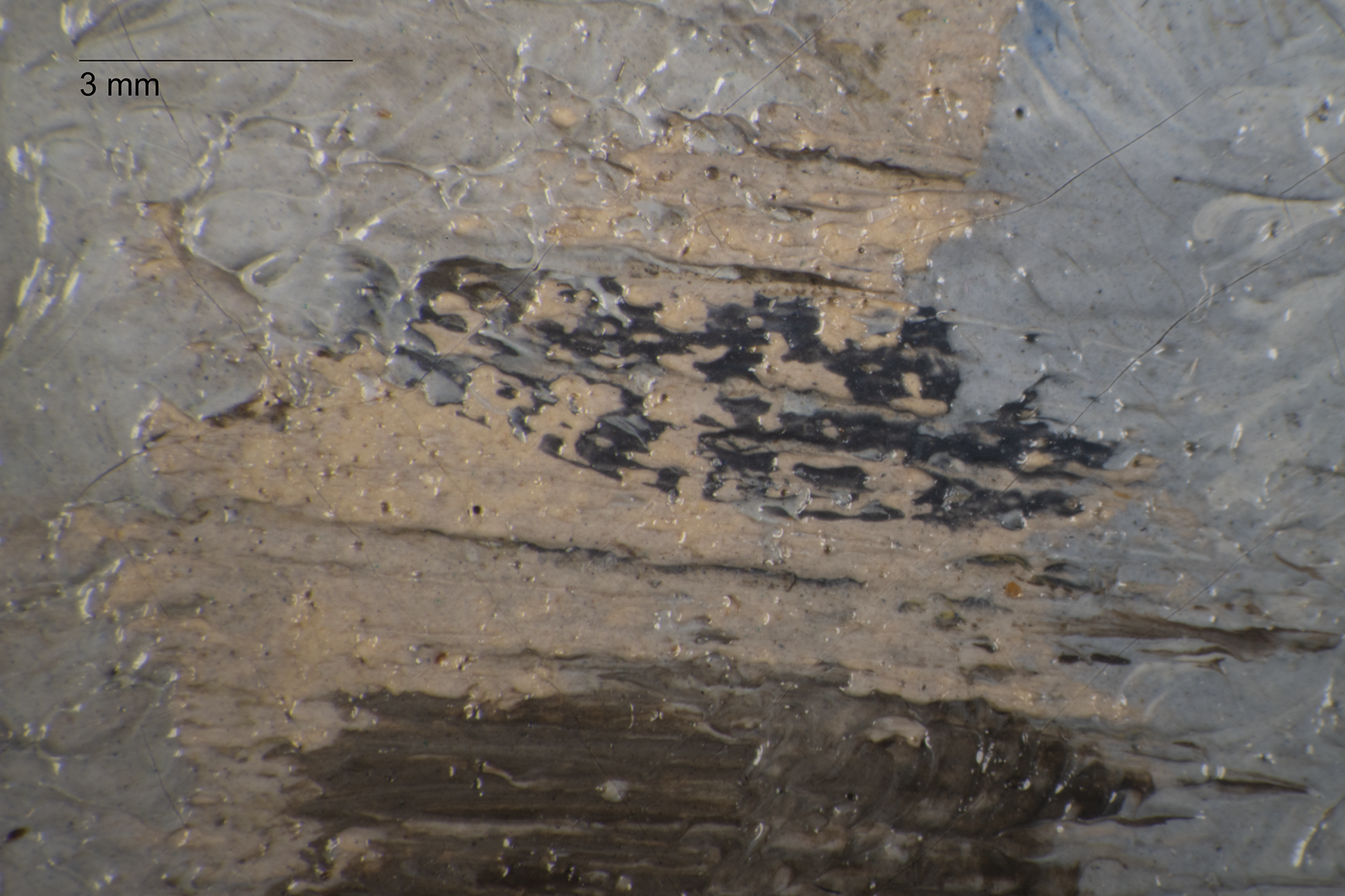 Fig. 22. Photomicrograph illustrating wet-over-dry application on lower black brushstroke in foreground of Snow Effect at Argenteuil (1875; 2015.13.14)
Fig. 22. Photomicrograph illustrating wet-over-dry application on lower black brushstroke in foreground of Snow Effect at Argenteuil (1875; 2015.13.14)
While there is no overall underdrawingunderdrawing: A drawn or painted sketch beneath the paint layer. The underdrawing can be made from dry materials, such as graphite or charcoal, or wet materials, such as ink or paint., thin black lines are found throughout the painting and likely relate to a partial underdrawing. These lines appear to have been created with charcoal,13While the academic tradition of underdrawing was not a fundamental concern for Monet, quick and sporadic charcoal lines for shape placements are present on some of his paintings, such as Houses by the Bank of the River Zaan (1871; Städel Museum). Felix Kramer, ed., Monet and the Birth of Impressionism (Munich: Prestel, 2015), 261–62. possibly oiled vine charcoal since the lines have been so well preserved.14Oiled vine charcoal has stronger binding properties than compressed charcoal, allowing for its possible preservation through restoration or conservation campaigns. Paul Goldman, Looking at Prints, Drawings and Watercolours (Los Angeles: The British Museum Press, 2006), 20. Some pressure was used to apply these lines, as the surrounding oil paint was displaced as they were drawn. In Figure 23, the green overlay corresponds to the charcoal lines and indicates that most relate to the present wintertime scene. Along the building at the left, they appear to relate directly to the current compositional elements of the snow scene, and lie between the blue and brown paint layers of the buildings (Fig. 24). It is not as clear how the charcoal lines on the right side relate to the painting. On this side, they appear to lie below the blue paint of the sky of the current composition and above a lower gray-blue that could relate to the early maritime scene. However, they do not clearly follow any compositional elements of Snow Effect at Argenteuil.
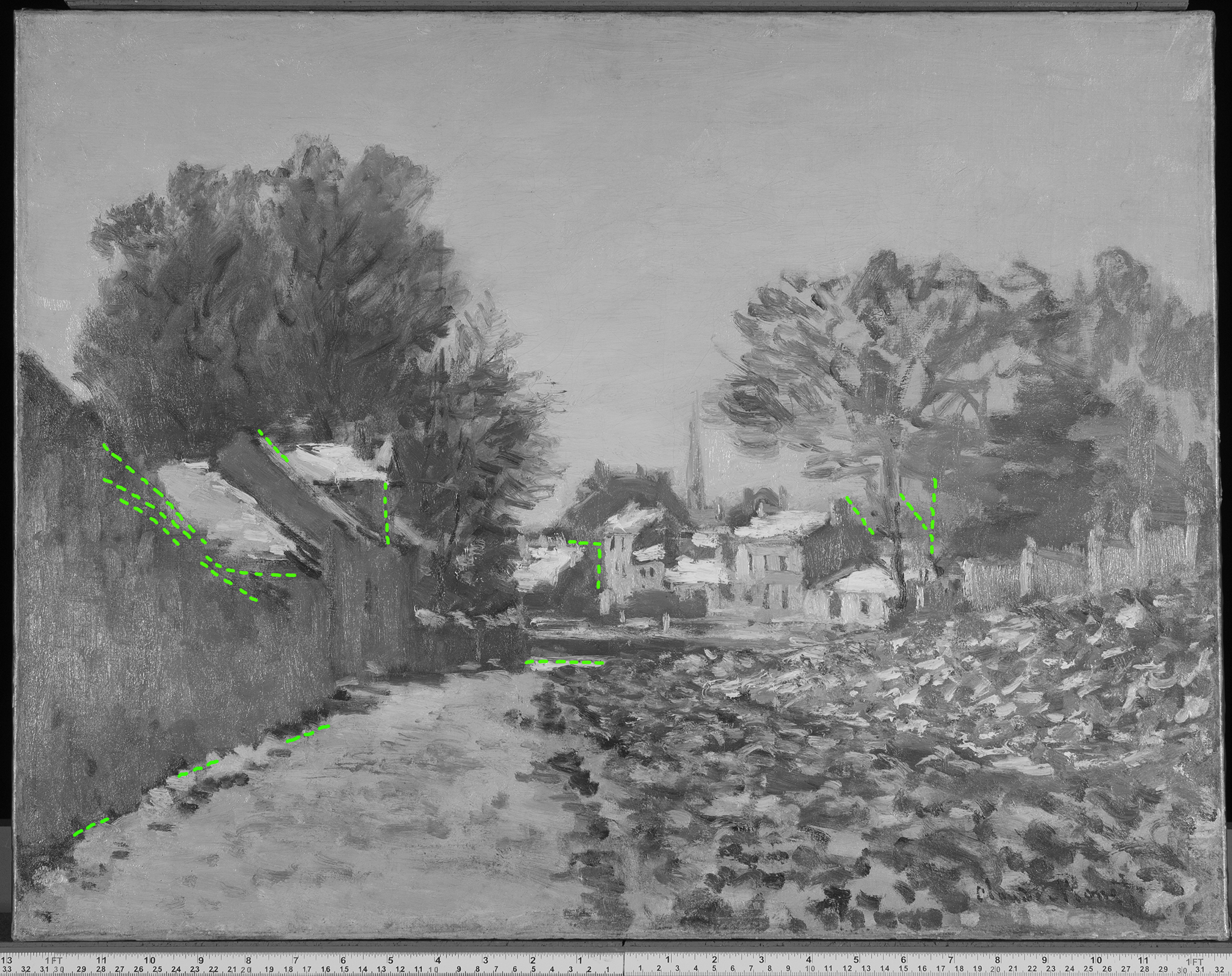 Fig. 23. Digital overlay of charcoal lines detected with a microscope, superimposed on a desaturated standard light image of Snow Effect at Argenteuil (1875; 2015.13.14)
Fig. 23. Digital overlay of charcoal lines detected with a microscope, superimposed on a desaturated standard light image of Snow Effect at Argenteuil (1875; 2015.13.14)
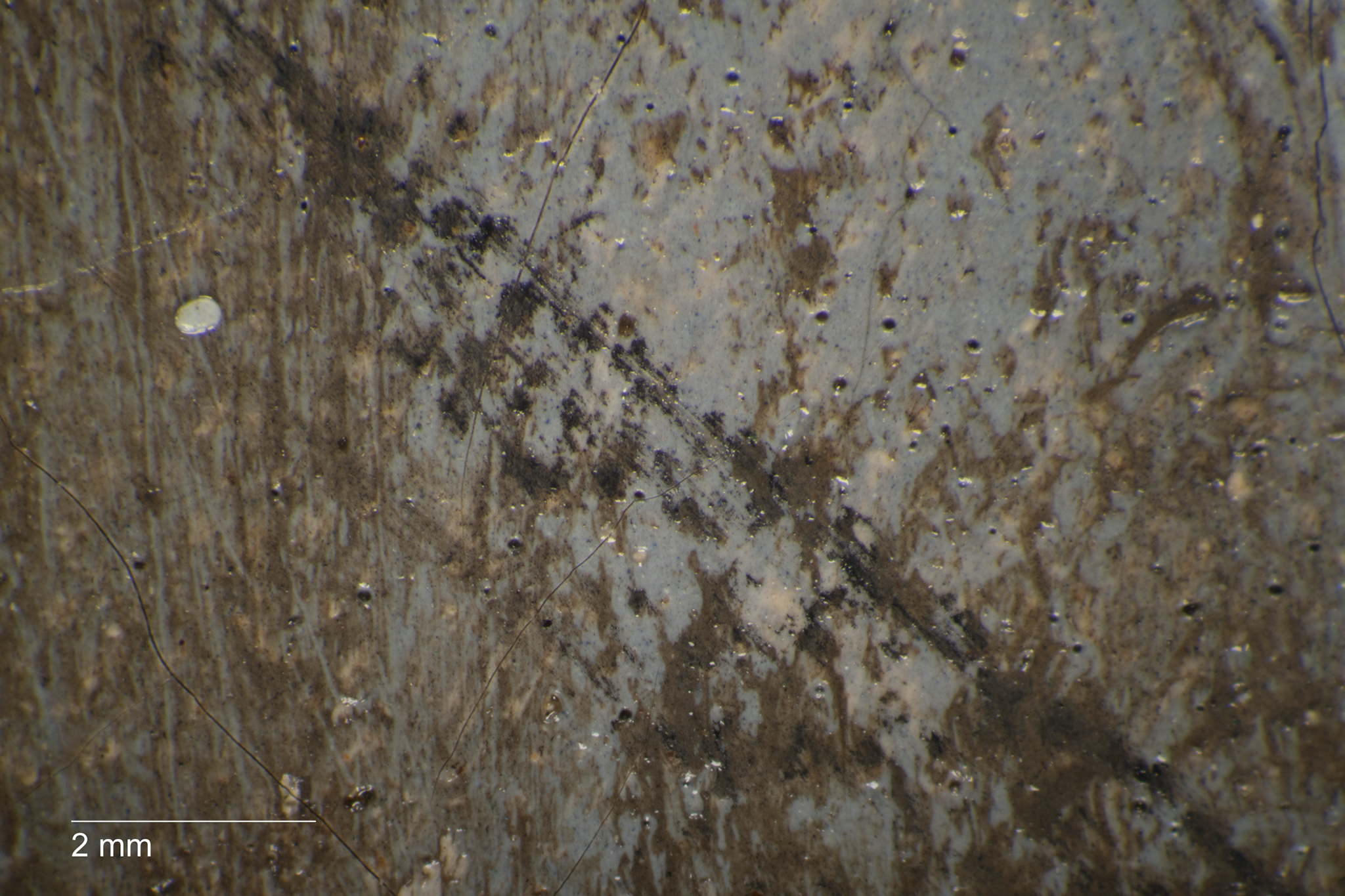 Fig. 24. Photomicrograph of charcoal line between the blue and brown layers of paint within the buildings on the left, Snow Effect at Argenteuil (1875; 2015.13.14)
Fig. 24. Photomicrograph of charcoal line between the blue and brown layers of paint within the buildings on the left, Snow Effect at Argenteuil (1875; 2015.13.14)
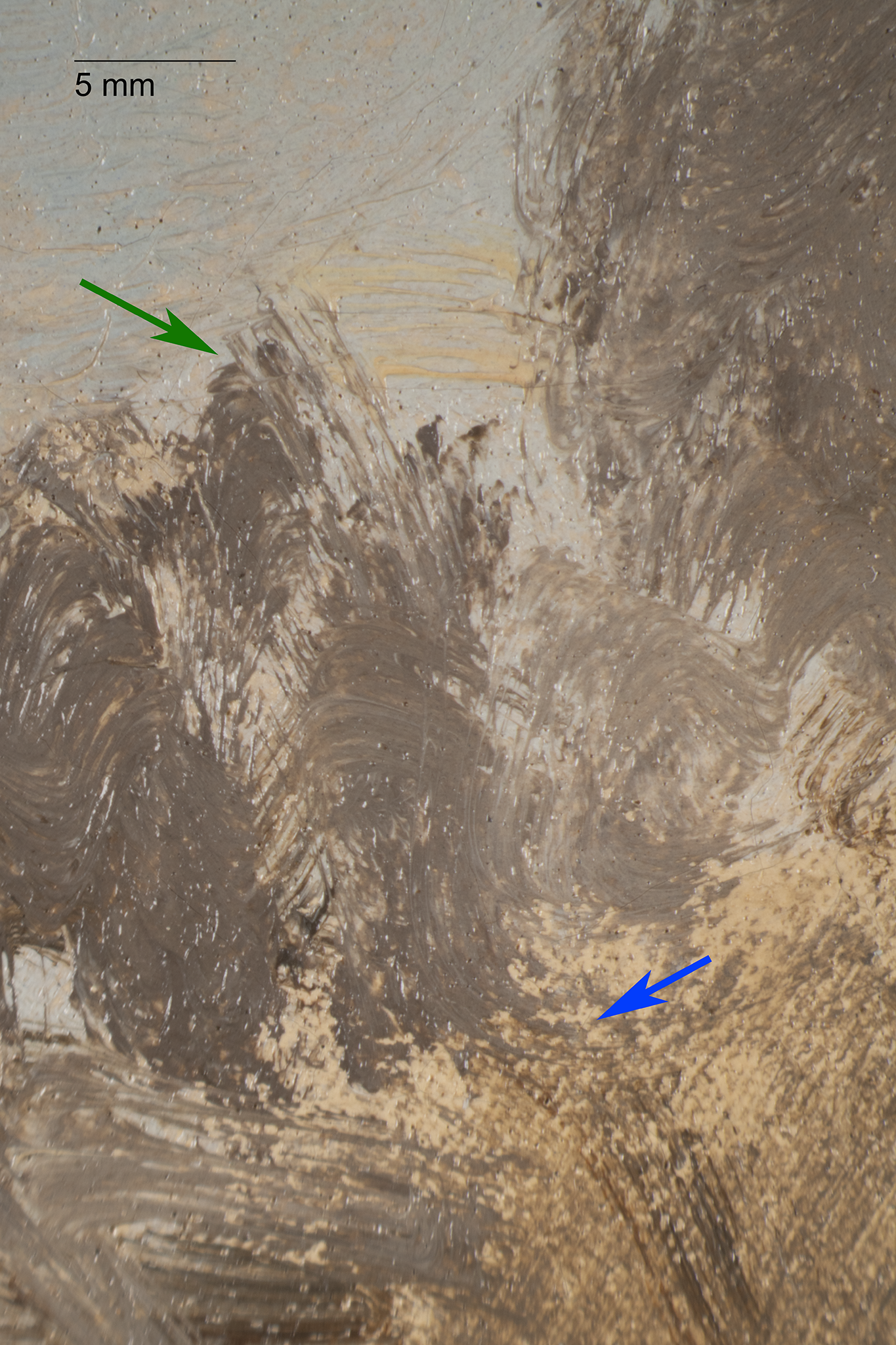 Fig. 25. Photomicrograph illustrating wet-over-wet paint application between the sky and outer branches (green arrow), and wet-over-dry paint application between the outer branches and initial laying in of the tree (blue arrow), in Snow Effect at Argenteuil (1875; 2015.13.14)
Fig. 25. Photomicrograph illustrating wet-over-wet paint application between the sky and outer branches (green arrow), and wet-over-dry paint application between the outer branches and initial laying in of the tree (blue arrow), in Snow Effect at Argenteuil (1875; 2015.13.14)
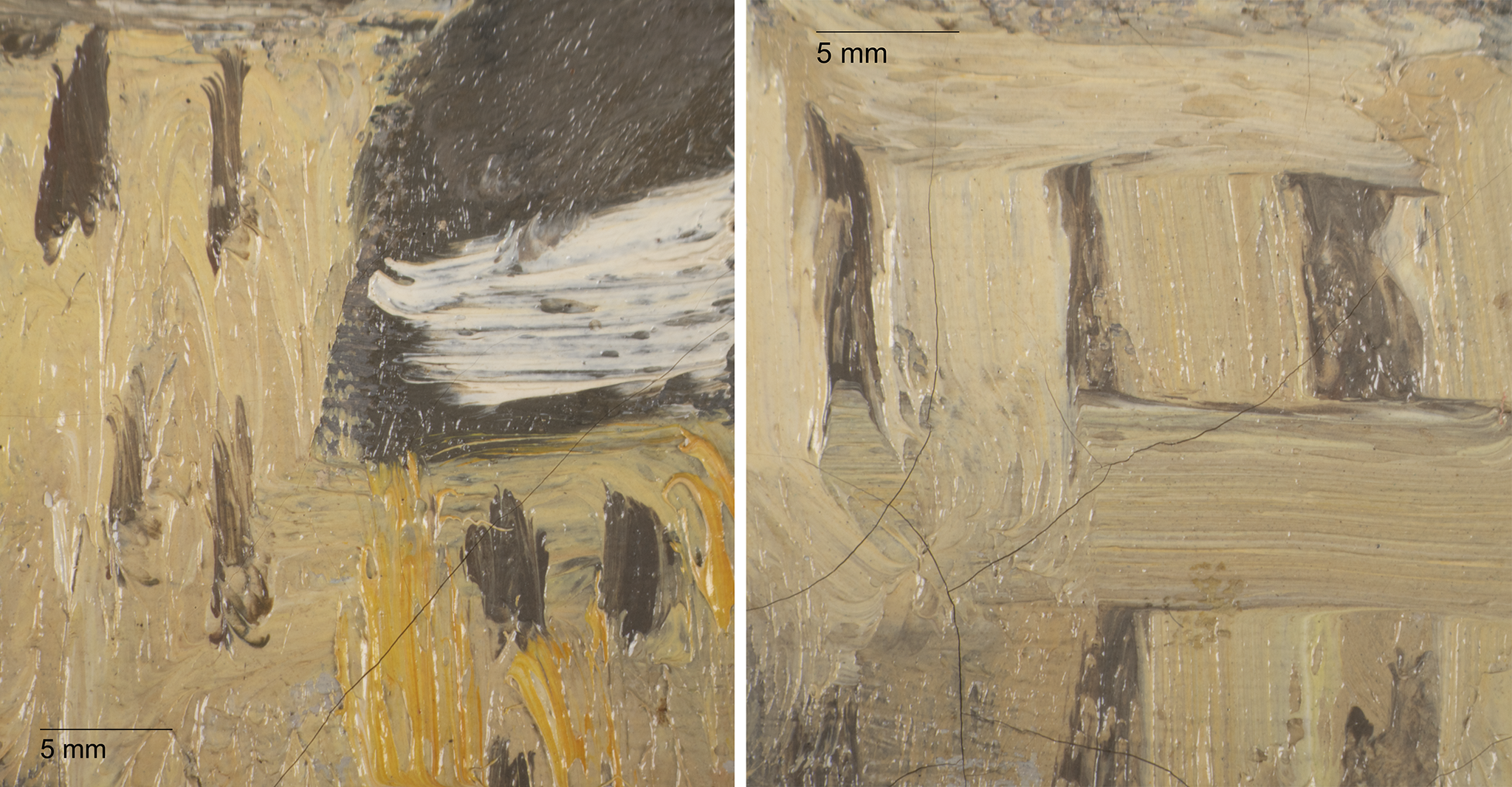
The painting is in good condition overall, with a glue-based lininglining: A procedure used to reinforce a weakened canvas that involves adhering a second fabric support using adhesive, most often a glue-paste mixture, wax, or synthetic adhesive. likely from an early date, though there are no records of when this was performed. There is minimal retouchingretouching: Paint application by a conservator or restorer to cover losses and unify the original composition. Retouching is an aspect of conservation treatment that is aesthetic in nature and that differs from more limited procedures undertaken solely to stabilize original material. Sometimes referred to as inpainting or retouch. present, with most relating to abrasionsabrasion: A loss of surface material due to rubbing, scraping, frequent touching, or inexpert solvent cleaning. along the edges. In 1988, a synthetic varnish was applied, which remains in good condition.
Notes
-
David Bomford, Jo Kirby, John Leighton, and Ashok Roy, Art in the Making: Impressionism (London: Yale University Press, 1991), 46. For more information on French canvas weaves, see also Anthea Callen, The Art of Impressionism: Painting Technique and the Making of Modernity (New Haven: Yale University Press, 2000), 31–32.
-
Because of the paper tape, it is difficult to determine if cusping is present on the top and left tacking margins.
-
For more information on the series of Argenteuil snow paintings, see the accompanying curatorial entry by Glynnis Napier Stevenson.
-
The Nelson-Atkins painting measures 50.2 x 64.5 centimeters. The Museum of Fine Arts Boston painting measures 54.6 x 73.7 centimeters. “Snow at Argenteuil,” The Museum of Fine Arts Boston, accessed July 27, 2020, https://collections.mfa.org/objects/31899/snow-at-argenteuil?ctx=509c6320-c57a-4933-b444-74faf1e92736&idx=18.
-
Callen, The Art of Impressionism, 15.
-
From the mid-1860s to the mid-1870s, Monet moved frequently, often finding himself in port cities such as Honfleur and Le Havre. During this time, he painting many scenes of ships and shipyards, with Ships in a Harbor being one example. Monet: The Early Years (New Haven: Yale University Press, 2017), 71–77.
-
The Museum of Fine Arts Boston painting Ships in a Harbor measures 49.8 x 61.0 centimeters, which roughly corresponds to a standard-format no. 12 portrait. “Ships in Harbor,” The Museum of Fine Arts Boston, accessed August 8, 2020, https://collections.mfa.org/objects/31270/ships-in-a-harbor?ctx=521deba2-9cf4-4795-84a9-c9560ca94b83&idx=5. See also Callen, The Art of Impressionism, 15.
-
Monet frequently purchased canvases with commercial grounds. Although he often applied a second tinted ground, paper tape around the tacking margins of the Nelson-Atkins painting makes it difficult to definitely state whether he followed this practice on Snow Effect at Argenteuil. The painting’s ground layer is off-white in color, and it is possible that no second layer was added by the artist. Bomford et al., Art in the Making: Impressionism, 144–45.
-
Wavy or “zigzag” brushstrokes are not uncommon for Monet’s representation of water and have been previously described in relation to his Bathing at La Grenouillère (1869; National Gallery, London). Anthea Callen, Techniques of the Impressionists (London: Tiger Books International, 1988), 56.
-
Most of the black strokes found in the foreground are beneath the current composition and thus have wet-onto-dry application. However, there is one black stroke in the center of the foreground that was painted contemporaneous to the current composition.
-
During the late 1860s Monet had immense financial struggles, frequently borrowing money from family and attempting suicide in 1868 because of his debts. Kermit Swiler Champa, Studies in Early Impressionism (New Haven: Yale University Press, 1973), 22–24. It was not until Monet fled to London in 1870 that he met the dealer Paul Durand-Ruel and became more financially stable. George T. M. Shackelford, Monet: The Early Years (New Haven: Yale University Press, 2017), 174. For a more complete timeline of Monet’s career, see pages 72–79.
-
Although Monet had become more financially stable after meeting Durand-Ruel, he continued to struggle with sales. For a discussion on Monet’s financial status in the 1870s, see the accompanying curatorial entry by Glynnis Napier Stevenson.
-
While the academic tradition of underdrawing was not a fundamental concern for Monet, quick and sporadic charcoal lines for shape placements are present on some of his paintings, such as Houses by the Bank of the River Zaan (1871; Städel Museum). Felix Kramer, ed., Monet and the Birth of Impressionism (Munich: Prestel, 2015), 261–62.
-
Oiled vine charcoal has stronger binding properties than compressed charcoal, allowing for its possible preservation through restoration or conservation campaigns. Paul Goldman, Looking at Prints, Drawings and Watercolours (Los Angeles: The British Museum Press, 2006), 20.
Documentation
Citation
Chicago:
Glynnis Napier Stevenson, “Claude Monet, Snow Effect at Argenteuil, 1875 (2015.13.14),” documentation in ed. Aimee Marcereau DeGalan French Paintings and Pastels, 1600–1945: The Collections of the Nelson-Atkins Museum of Art (Kansas City: The Nelson-Atkins Museum of Art, 2021), https://doi.org/10.37764/78973.5.629.4033.
MLA:
Stevenson, Glynnis Napier. “Claude Monet, Snow Effect at Argenteuil, 1875 (2015.13.14),” documentation. French Paintings and Pastels, 1600–1945: The Collections of the Nelson-Atkins Museum of Art, edited by Aimee Marcereau DeGalan, The Nelson-Atkins Museum of Art, 2021. doi: 10.37764/78973.5.629.4033
Provenance
Citation
Chicago:
Glynnis Napier Stevenson, “Claude Monet, Snow Effect at Argenteuil, 1875 (2015.13.14),” documentation in ed. Aimee Marcereau DeGalan French Paintings and Pastels, 1600–1945: The Collections of the Nelson-Atkins Museum of Art (Kansas City: The Nelson-Atkins Museum of Art, 2021), https://doi.org/10.37764/78973.5.629.4033.
MLA:
Stevenson, Glynnis Napier. “Claude Monet, Snow Effect at Argenteuil, 1875 (2015.13.14),” documentation. French Paintings and Pastels, 1600–1945: The Collections of the Nelson-Atkins Museum of Art, edited by Aimee Marcereau DeGalan, The Nelson-Atkins Museum of Art, 2021. doi: 10.37764/78973.5.629.4033.
Probably with the artist, until at least June 21, 1889 [1];
With Galerie Georges Petit, Paris, by October 19, 1892;
Purchased from Galerie Georges Petit, Paris, by Boussod, Valadon et Cie, Paris, stock no. 22538, as Entrée de Village, neige, October 19, 1892 [2];
Transferred from Boussod, Valadon et Cie, Paris, to Boussod, Valadon et Cie, New York, by April 15, 1898;
Purchased from Boussod, Valadon et Cie, New York, by Henry Osborne (1847–1907) and Louisine Waldron (née Elder, 1855–1929) Havemeyer, New York, 1898–December 4, 1907;
Inherited by Louisine Waldron Elder Havemeyer, New York, 1907–January 6, 1929;
Purchased at her posthumous sale, Important Paintings from the Havemeyer Estate, Part I, American Art Association, New York, April 10, 1930, lot 85, as Village Street, by H. E. Russell for David Melville (1891–1984) and Ruth (née Stein, 1899–1979) Heyman, 1930–1984;
Purchased at their posthumous sale, Impressionist and Modern Paintings and Sculpture, Christie’s, New York, May 16, 1984, lot 8, as Neige a [sic] Argenteuil, by Alex Reid and Lefèvre Ltd., London, 1984–June 8, 1988 [3];
Purchased from Alex Reid and Lefèvre Ltd., through Susan L. Brody Associates, New York, by Marion (née Helzberg, 1931–2013) and Henry (1922–2019) Bloch, Shawnee Mission, KS, 1988–June 15, 2015 [4];
Their gift to The Nelson-Atkins Museum of Art, Kansas City, MO, 2015.
Notes
[1] The painting was exhibited at Claude Monet; A. Rodin at Galerie Georges Petit, Paris, which opened on June 21, 1889. Many of the other pictures exhibited have a specified lender, but not lot 18, titled Effet de neige; Argenteuil, which means that Monet probably lent the work from his private collection. Pictures owned by Georges Petit in 1889 were listed as such in the exhibition catalogue.
[2] This picture entered the Boussod, Valadon, et Cie stockbook on October 19, 1892. See “Goupil Book 14, Stock No. 22538, Page 31, Row 2,” The Getty Research Institute, Los Angeles, Dealer Stock Books, as Entrée de Village, neige.
[3] See email from Darragh O’Donoghue, Tate Archives, to Glynnis Stevenson, NAMA, October 30, 2018, NAMA curatorial files.
[4] Phone call from Susan Brody to Brigid Boyle, NAMA, June 10, 2015, see notes in NAMA curatorial files.
Related Works
Citation
Chicago:
Glynnis Napier Stevenson, “Claude Monet, Snow Effect at Argenteuil, 1875 (2015.13.14),” documentation in ed. Aimee Marcereau DeGalan French Paintings and Pastels, 1600–1945: The Collections of the Nelson-Atkins Museum of Art (Kansas City: The Nelson-Atkins Museum of Art, 2021), https://doi.org/10.37764/78973.5.629.4033.
MLA:
Stevenson, Glynnis Napier. “Claude Monet, Snow Effect at Argenteuil, 1875 (2015.13.14),” documentation. French Paintings and Pastels, 1600–1945: The Collections of the Nelson-Atkins Museum of Art, edited by Aimee Marcereau DeGalan, The Nelson-Atkins Museum of Art, 2021. doi: 10.37764/78973.5.629.4033.
Snow at Argenteuil, about 1874, oil on canvas, 21 1/2 x 29 in (54.6 x 73.7 cm), Museum of Fine Arts, Boston.
Exhibitions
Citation
Chicago:
Glynnis Napier Stevenson, “Claude Monet, Snow Effect at Argenteuil, 1875 (2015.13.14),” documentation in ed. Aimee Marcereau DeGalan French Paintings and Pastels, 1600–1945: The Collections of the Nelson-Atkins Museum of Art (Kansas City: The Nelson-Atkins Museum of Art, 2021), https://doi.org/10.37764/78973.5.629.4033.
MLA:
Stevenson, Glynnis Napier. “Claude Monet, Snow Effect at Argenteuil, 1875 (2015.13.14),” documentation. French Paintings and Pastels, 1600–1945: The Collections of the Nelson-Atkins Museum of Art, edited by Aimee Marcereau DeGalan, The Nelson-Atkins Museum of Art, 2021. doi: 10.37764/78973.5.629.4033.
Claude Monet; A. Rodin, Galerie Georges Petit, Paris, opened June 21, 1889, no. 18, as Effet de neige; Argenteuil.
A Loan Exhibition of Paintings by Claude Monet For the Benefit of The Children of Giverny, Wildenstein, New York, April 11–May 12, 1945, no. 10, as Rue de Village en Normandie.
Important XIX and XX Century Works of Art, The Lefevre Gallery, London, June 20–July 27, 1985, no. 10, as Neige à Argenteuil.
Manet to Matisse: Impressionist Masters from the Marion and Henry Bloch Collection, The Nelson-Atkins Museum of Art, Kansas City, MO, June 9–September 9, 2007, no. 9, as Snow at Argenteuil (Neige à Argenteuil).
References
Citation
Chicago:
Glynnis Napier Stevenson, “Claude Monet, Snow Effect at Argenteuil, 1875, and Snow Effect at Argenteuil, 1875,” documentation in ed. Aimee Marcereau DeGalan French Paintings and Pastels, 1600–1945: The Collections of the Nelson-Atkins Museum of Art (Kansas City: The Nelson-Atkins Museum of Art, 2021), https://doi.org/10.37764/78973.5.629.4033.
MLA:
Stevenson, Glynnis Napier. “Claude Monet, Snow Effect at Argenteuil, 1875, and Snow Effect at Argenteuil, 1875,” documentation. French Paintings and Pastels, 1600–1945: The Collections of the Nelson-Atkins Museum of Art, edited by Aimee Marcereau DeGalan, The Nelson-Atkins Museum of Art, 2021. doi: 10.37764/78973.5.629.4033.
Claude Monet; A. Rodin, exh. cat. (Paris: Galerie Georges Petit, 1889), 29 [repr., in Theodore Reff, ed., Modern Art in Paris: Two-Hundred Catalogues of the Major Exhibitions Reproduced in Facsimile in Forty-Seven Volumes, vol. 34, Miscellaneous Group Exhibitions (New York: Garland, 1981), unpaginated], as Effet de neige; Argenteuil.
Possibly Gustave Geffroy, Claude Monet, sa vie, son œuvre, vol. 1 (Paris: Les Éditions G. Crès et Cie, 1924), 156, as Effet de neige à Argenteuil.
The Estate of Mrs. H. O. Havemeyer, Part I: Oil Paintings (New York: American Art Association, Anderson Galleries, April 10, 1930), 63, (repro.), as Village Street.
The H. O. Havemeyer Collection: Catalogue of Paintings, Prints, Sculpture and Objects of Art (Portland, ME: Southworth Press, 1931), 504, as Landscape—Village Street.
A Loan Exhibition of Paintings by Claude Monet For the Benefit of the Children of Giverny, exh. cat. (New York: Wildenstein, 1944), 24, as Rue de Village en Normandie.
Impressionism in the collection of the Museum of Fine Arts, Boston (Boston: Museum of Fine Arts, 1973), unpaginated.
Daniel Wildenstein, Claude Monet: Biographie et catalogue raisonné, vol. 1, 1840–1881: Peintures (Lausanne: La Bibliothèque des Arts, 1974), no. 349, pp. 73, 262–63, 460, as Neige à Argenteuil.
Impressionist and Modern Paintings and Sculpture (New York: Christie’s, May 16, 1984), 26, (repro.), as Neige a [sic] Argenteuil.
Important XIX and XX Century Works of Art, exh. cat. (London: Lefevre Gallery, 1985), 22–23, as Neige à Argenteuil.
John House, Monet: Nature into Art (New Haven, CT: Yale University Press, 1986), 167–68, (repro.), as Snow at Argenteuil.
Frances Weitzenhoffer, The Havemeyers: Impressionism Comes to America (New York: Harry N. Abrams, 1986), 130, 237, (repro.), as Snow at Argenteuil.
Daniel Wildenstein, Claude Monet: Catalogue raisonné, vol. 5, Supplément aux peintures, Dessins, Pastels, Index (Lausanne: Wildenstein Institute, 1991), no. 349, pp. 29, 292, 328, 332, 336, as Neige à Argenteuil.
Alice Cooney Frelinghuysen, et al., Splendid Legacy: The Havemeyer Collection, exh. cat. (New York: Metropolitan Museum of Art, 1993), 223, 362–63, (repro.), as Snow at Argenteuil.
Daniel Wildenstein, Monet or the Triumph of Impressionism (Cologne: Benedikt Taschen Verlag GmbH, 1996), no. 349, p. 114.
Daniel Wildenstein, Monet: Catalogue Raisonné-Werkverzeichnis, vol. 2, Nos. 1–968 (Cologne: Benedikt Taschen Verlag GmbH, 1996), no. 349, p. 144, (repro.), as Neige à Argenteuil, Snow at Argenteuil, and Schnee in Argenteuil.
Charles S. Moffett et al., Impressionists in Winter: Effets de Neige, exh. cat. (Washington, DC: Phillips Collection, 1998), 96–97, (repro.), as Snow at Argenteuil.
Rebecca Dimling and Bobbie Leigh, “100 Top Collectors Who Have Made a Difference,” Art and Antiques (March 2006): 90.
Bobbie Leigh, “Magnificent Obsession,” Art and Antiques 29, no. 6 (June 2006): 62, 64–65, (repro.).
“Inaugural Exhibitions Celebrate Kansas City,” Member Magazine (The Nelson-Atkins Museum of Art) (Fall 2006): 3.
Richard R. Brettell and Joachim Pissarro, Manet to Matisse: Impressionist Masters from the Marion and Henry Bloch Collection, exh. cat. (Kansas City, MO: Nelson-Atkins Museum of Art, 2007), 10, 14, 60–65, 68–69, 157, (repro.), as Snow at Argenteuil (Neige à Argenteuil).
Alice Thorson, “A final countdown—A rare showing of Impressionist paintings from the private collection of Henry and Marion Bloch is one of the inaugural exhibitions at the 165,000-square-foot glass-and-steel structure,” Kansas City Star (June 29, 2006): B1.
Alice Thorson, “First Public Exhibition-Marion and Henry Bloch’s art collection: A tiny Renoir began impressive obsession Bloch collection gets its first public exhibition-After one misstep, Blochs focused, successfully, on French paintings,” Kansas City Star (June 3, 2007): E4.
“Lasting Impressions: A Tribute to Marion and Henry Bloch,” Member Magazine (The Nelson-Atkins Museum of Art) (Fall 2007): 11.
Steve Paul, “Pretty Pictures: Marion and Henry Bloch’s collection of superb Impressionist masters,” Panache 4, no. 3 (Fall 2007): 24, (repro.), as Snow at Argenteuil.
Joseph Baillio, Claude Monet (1840–1926): A Tribute to Daniel Wildenstein and Katia Granoff, exh. cat. (New York: Wildenstein, 2007), 144, as Snow at Argenteuil.
Alice Thorson, “Museum to Get 29 Impressionist Works from the Bloch Collection,” The Kansas City Star (February 5, 2010): A1.
Carol Vogel, “Inside Art: Kansas City Riches,” New York Times 159, no. 54,942 (February 5, 2010): C26, (repro.), as Snow at Argenteuil.
Mary Mathews Gedo, Monet and his Muse: Camille Monet in the Artist’s Life (Chicago: University of Chicago Press, 2010), 155.
Daniel Wildenstein, Monet or the Triumph of Impressionism (Cologne: Benedikt Taschen Verlag GmbH, 2010), no. 349, p. 114.
Thomas M. Bloch, Many Happy Returns: The Story of Henry Bloch, America’s Tax Man (Hoboken, NJ: John Wiley and Sons, 2011), 174–75.
Possibly Jean-François Demeure, Monet en Creuse: Le printemps d’une méthode (Limoges, France: Éditions Culture et Patrimoine en Limousin, 2011), 38, as Effet de neige à Argenteuil.
Diane Stafford, “Bloch gift to go for Nelson upgrade,” Kansas City Star 135, no. 203 (April 8, 2015): A8.
“Nelson-Atkins Museum of Art officially accessions Bloch Impressionist masterpieces,” artdaily.org (July 25, 2015): http://artdaily.com/news/80246/Nelson-Atkins-Museum-of-Art-officially-accessions-Bloch-Impressionist-masterpieces#.V6oGwlKFO9I.
Julie Paulais, “Le Nelson-Atkins Museum of Art reçoit des tableaux impressionnistes en échange de leurs répliques,” Le Journal des arts (July 30, 2015): <http://www.lejournaldesarts.fr/site/archives/docs_article/129801/le-nelson-atkins-museum-of-art-recoit-des-tableaux-impressionnistes-en-echange-de-leurs-repliques.php>.
Josh Niland, “The Nelson-Atkins Museum of Art Acquires a Renowned Collection of Impressionist and Postimpressionist Art,” architecturaldigest.com (August 6, 2015): https://www.architecturaldigest.com/story/nelson-atkins-museum-accessions-bloch-art-collection.
Nancy Staab, “Van Gogh is a Go!” 435: Kansas City’s Magazine (September 2015): 76.
Nina Siegal, “Upon Closer Review, Credit Goes to Bosch,” New York Times 165, no. 57130 (February 2, 2016): C5.
“Nelson-Atkins to unveil renovated Bloch Galleries of European Art in winter 2017,” Artdaily.org (July 20, 2016): http://artdaily.com/news/88852/Nelson-Atkins-to-unveil-renovated-Bloch-Galleries-of-European-Art-in-winter-2017-#.W-NDepNKhaQ.
“Nelson-Atkins Museum of Art celebrates generosity of Henry Bloch with new acquisition,” Artdaily.org (October 18, 2016): http://artdaily.com/news/90923/Nelson-Atkins-Museum-of-Art-celebrates-generosity-of-Henry-Bloch-with-new-acquisition#.W-NDv5NKhaQ.
Ross King, Mad Enchantment: Claude Monet and the Painting of the Water Lilies (New York: Bloomsbury, 2016), 120.
Catherine Futter et al., Bloch Galleries: Highlights from the Collection of the Nelson-Atkins Museum of Art (Kansas City, MO: Nelson-Atkins Museum of Art, 2016), 61, (repro.), as Snow at Argenteuil.
David Frese, “Bloch savors paintings in redone galleries,” Kansas City Star (February 25, 2017): 1A.
Albert Hect, “Henry Bloch’s Masterpieces Collection to Go on Display at Nelson-Atkins Museum,” Jewish Business News (February 26, 2017): http://jewishbusinessnews.com/2017/02/26/henry-bloch-masterpieces-collection/.
David Frese, “Inside the Bloch Galleries: An interactive experience,” Kansas City Star 137, no. 169 (March 5, 2017): 1D, 5D, (repro.), as Snow at Argenteuil.
“The Nelson-Atkins Museum of Art: Presenting the Bloch Galleries,” New York Times (March 5, 2017).
“Editorial: Thank you, Henry and Marion Bloch”, Kansas City Star (March 7, 2017): http://www.kansascity.com/opinion/editorials/ article137040948.html [repr., “Thank you, Henry and Marion Bloch,” Kansas City Star 137, no. 172 (March 8, 2017): 16A].
Hampton Stevens, “(Not Actually) 12 Things To Do During The Big 12 Tournament,” Flatland: KCPT’s Digital Magazine (March 9, 2017): http://www.flatlandkc.org/arts-culture/sports/not-actually-12-big-12-tournament/.
Laura Spencer, “The Nelson-Atkins’ Bloch Galleries Feature Old Masterworks and New Technology,” KCUR (March 10, 2017): http://kcur.org/post/nelson-atkins-bloch-galleries-feature-old-masterworks-and-new-technology#stream/0.
Victoria Stapley-Brown, “Nelson-Atkins Museum’s new European art galleries come with a ‘love story,’” Art Newspaper (March 10, 2017): http://theartnewspaper.com/news/museums/nelson-atkins-museum-s-new-european-art-galleries-come-with-a-love-story/.
Harry Bellet, “Don du ciel pour le Musée Nelson-Atkins,” Le Monde (March 13, 2017): http://www.lemonde.fr/arts/article/2017/03/13/don-du-ciel-pour-le-musee-nelson-atkins_5093543_1655012.html.
Menachem Wecker, “Jewish Philanthropist Establishes Kansas City as Cultural Mecca,” Forward (March 14, 2017): http://forward.com/culture/365264/jewish-philanthropist-establishes-kansas-city-as-cultural-mecca/ [repr., in Menachem Wecker, “Kansas City Collection Is A Chip Off the Old Bloch,” Forward (March 17, 2017): 20-22], as Snow at Argenteuil.
Juliet Helmke, “The Bloch Collection Takes up Residence in Kansas City’s Nelson Atkins Museum,” BlouinArtInfo International (March 15, 2017): http://www.blouinartinfo.com/news/story/2005267/the-bloch-collection-takes-up-residence-in-kansas-citys.
Erich Hatala Matthes, “Digital replicas are not soulless – they help us engage with art,” Apollo (March 23, 2017): https://www.apollo-magazine.com/digital-replicas-3d-printing-original-artworks/.
Louise Nicholson, “How Kansas City got its magnificent museum,” Apollo (April 7, 2017): https://www.apollo-magazine.com/how-kansas-city-got-its-magnificent-museum/.
Lilly Wei, “Julián Zugazagoitia: ‘Museums should generate interest and open a door that leads to further learning,’” Studio International (August 21, 2017): http://studiointernational.com/index.php/julian-zugazagoitia-director-nelson-atkins-museum-of-art-kansas-city-interview.
Richard Thomson, Monet and Architecture, exh. cat. (London: National Gallery Company, 2018), 218.
Robert D. Hershey Jr., “Henry Bloch, H&R Block’s cofounder, dies at 96,” Boston Globe (April 23, 2019): <https://www3.bostonglobe.com/metro/obituaries/2019/04/23/henry-bloch-block-cofounder/?arc404=true>.
Robert D. Hershey Jr., “Henry W. Bloch, Tax-Preparation Pioneer (and Pitchman), Is Dead at 96,” New York Times (April 23, 2019), https://www.nytimes.com/2019/04/23/obituaries/henry-w-bloch-dead.html.
Claire Selvin, “Henry Wollman Bloch, Collector and Prominent Benefactor of Nelson-Atkins Museum of Art, Is Dead at 96,” ArtNews (April 23, 2019): http://www.artnews.com/2019/04/23/henry-bloch-dead-96/](http://www.artnews.com/2019/04/23/henry-bloch-dead-96/.
“Henry Wollman Bloch (1922-2019),” Art Forum (April 24, 2019): https://www.artforum.com/news/henry-wollman-bloch-1922-2019-79547.
Frank Morris, “Henry Bloch, Co-Founder Of H&R Block, Dies At 96,” npr.org (April 24, 2019): https://www.npr.org/2019/04/24/716641448/henry-bloch-co-founder-of-h-r-block-dies-at-96.
Ignacio Villarreal, “Nelson-Atkins mourns loss of Henry Bloch,” ArtDaily.org (April 24, 2019): http://artdaily.com/news/113035/Nelson-Atkins-mourns-loss-of-Henry-Bloch#.XMB76qR7laQ.
Eric Adler and Joyce Smith, “H&R Block co-founder, philanthropist Bloch dies,” Cass County Democrat Missourian 140, no. 29 (April 26, 2019): 1A.
Eric Adler and Joyce Smith, “KC businessman and philanthropist Henry Bloch dies,” Lee’s Summit Journal 132, no. 79 (April 26, 2019): 1A.
Luke Nozicka, “Family and friends remember Henry Bloch of H&R Block,” Kansas City Star 139, no. 225 (April 30 2019): 4A [repr., Luke Nozicka, “Family and friends remember Henry Bloch of H&R Block,” Kansas City Star 139, no. 228 (May 3, 2019): 3A].
